
Linz

Anton Bruckner in Linz
1840 to 1841 Training as an elementary school teacher in the preparatory school at Hofgasse 23.
1855 return to Linz as cathedral and city parish organist with official residence in the Mesnerstöckel at Pfarrplatz 164. Singer and successful choirmaster of the Liedertafel Frohsinn. Private teacher of Ludwig Boltzmann, among others. Musical studies with theatre conductor Otto Kitzler in Linz and Simon Sechter in Vienna. Compositions include the 1st Symphony and three large masses.
1869 composition of the Locus iste for the consecration of the Votive Chapel of St. Mary's Cathedral.
Events in Linz
Heute
bis Sa. 02.11.24
00:00-24:00
Linz
Ölbergkapelle
Bruckner Schrein

Bruckner Schrein

128 years after the death of Bruckner, Peter Androsch lays the composer out again. In the Mount of Olives Chapel on the north-eastern side of the parish church in Linz, where Bruckner was the organist for 13 years. Six guardian angels watch over him. They are his siblings who died at a tender age. The shrine is illuminated five times a day.
With the kind support of the City of Linz, the VKB bank and Linzer Bier!
Peter Androsch
Peter Androsch
Pfarrplatz 20 4020 Linz
Heute
bis Fr. 27.09.24
09:00-21:00
Linz
OÖ Kulturquartier
Alles Bruckner?

Alles Bruckner?

2024 is the memorial year for Anton Bruckner, the Fotografische Gesellschaft is taking part in this commemorative year and offering a variety of approaches to Bruckner: as a musician, as a person and as a driven man.
The aim of the exhibition is to shed light on Bruckner's life and work from different perspectives and to present its complexity. Bruckner as a musician: The focus here is on Bruckner's musical legacy. His symphonies, organ works and other compositions take center stage and demonstrate his musical creativity.
Bruckner the man: This perspective is dedicated to Bruckner's personality and his life outside of music. Here the photographic works tell of his life as a person, as a musician in the provinces and his environment. Bruckner the driven man: This aspect sheds light on the inner struggles and challenges that Bruckner had to face. These include his self-doubt, criticism during his lifetime and his tireless pursuit of perfection in his music.
The diversity in the works of the Fotografische Gesellschaft attempts to honor and show Bruckner in all his complexity. Through different artistic approaches and interpretations, the public is offered the opportunity to get to know Bruckner from new perspectives.
Upper Austrian Photographic Society
Landstrasse 31 4020 Linz Details & Tickets
Heute
bis So. 29.12.24
10:00-17:00
Linz
Ars Electronica Center
Being Anton

Being Anton

Ars Electronica Center Linz
Duration of the exhibition: 01.02. - 31.12.2024, Tue - Sun 10:00 - 17:00
The immersive sound space "Being Anton" at the Ars Electronica Center in Linz offers visitors the opportunity to explore Bruckner's world of sound in a completely new way. After all, when we think of Anton Bruckner, we usually think of his legacy, i.e. Bruckner's music and his sounds. But what soundscape surrounded Bruckner himself? What did he listen to in his everyday life? His life was characterized by many social upheavals triggered by the industrial revolution. The steam engine, for example, which was used in steam trains and steamships, not only changed people's mobility options at an unprecedented pace, but also brought a completely new soundscape into the world.
The installation "Being Anton", developed by the Ars Electronica Futurelab, allows visitors to immerse themselves in this world of sound that surrounded Anton Bruckner and his contemporaries. The link with examples from Bruckner's musical oeuvre creates points of contact between the two sound worlds.
A project of the Upper Austrian KulturEXPO Anton Bruckner 2024 and the Ars Electronica Center
Ars-Electronica-Strasse 1 4040 Linz Details & Tickets
Heute
bis Di. 31.12.24
16:30 - 17:00 Uhr
Linz
Ars Electronica Center
Playing Anton

Playing Anton

Ars Electronica Center Linz, Deep Space 8K
Duration of the exhibition: 01.02. - 31.12.2024, Tue - Sun at 16:30 each day
What makes up the gigantic, imposing sound of a Bruckner symphony? Visitors can approach this question in a playful way with "Playing Anton" in Deep Space 8K at the Ars Electronica Center: Playing together with other visitors, they can constantly re-form the various instrumental groups of the Bruckner Orchestra Linz thanks to the innovative interaction technology of Deep Space 8K. Various facets of the musical and compositional perception of Bruckner's music are illuminated, enhanced by impressive 3D visualizations.
For example, "Playing Anton" - developed by the Ars Electronica Futurelab - allows visitors to immerse themselves visually and musically in Anton Bruckner's impressive world of sound together with the Bruckner Orchestra Linz and interactively explore its special features. Not just as listeners in front of the stage, but right in the middle of the orchestra.
A project of the Upper Austrian KulturEXPO Anton Bruckner 2024 and the Ars Electronica Center
Ars-Electronica-Strasse 1 4040 Linz Details & Tickets
Heute
bis So. 29.12.24
Linz
Ars Electronica Center
Tour: Playing, Being… Experiencing Anton

Tour: Playing, Being… Experiencing Anton

You only turn 200 once! We are celebrating Anton Bruckner, why don't you join us! Visit our walk-in and interactive sound experiences on a guided walk and immerse yourself in the world of Bruckner.
Playing Anton
What is the gigantic, imposing sound of a Bruckner symphony made of? Playing Anton" in Deep Space 8K at the Ars Electronica Centre gives visitors the opportunity to approach this question in a playful manner": Together with other visitors, they can constantly re-arrange the various instrumental groups of the Bruckner Orchestra Linz using the innovative and interactive technology of Deep Space 8K. Various facets of the musical and compositional perception of Bruckner's music are illuminated and reinforced by impressive 3D visualisations.
For example, "Playing Anton" - which was developed by the Ars Electronica Futurelab - allows visitors to immerse themselves visually and musically in Anton Bruckner's impressive world of sound together with the Bruckner Orchestra Linz. They can then explore its special features in an interactive manner, not just as listeners in front of the stage, but from right in the middle of the orchestra.
Being Anton
The immersive "Being Anton" acoustic space at the Ars Electronica Centre in Linz allows visitors to explore Bruckner's world of sound in a completely new way. After all, when we think of Anton Bruckner, we usually think about his legacy, i.e. the music and sounds of Bruckner. But what acoustic space surrounded Bruckner himself? What did he listen to in his everyday life? His life was shaped by many social upheavals triggered by the industrial revolution. The steam engine, for example, which was used in steam trains and steamers, presented the people of that time with new mobility options at an unprecedented pace and also introduced new elements of sound to the world.
The installation "Being Anton", developed by the Ars Electronica Futurelab, allows visitors to immerse themselves in the world of sound that prevailed in the day of Anton Bruckner and his contemporaries. Linking the latter to examples from Bruckner's creative work generates points of contact between these two worlds of sound.
TOUR
THUR, SAT, SUN and public holidays, as well as during the Upper Austrian school vacations: 15:30 - 16:30
Duration: 60 minutes
Price: € 5.00
A project of the Upper Austrian KulturEXPO Anton Bruckner 2024 and the Ars Electronica Center
Ars-Electronica-Strasse 1 4040 Linz
Di. 30.07.24
bis Do. 01.08.24
9:00-12:30
Linz
Kinderkulturzentrum Kuddelmuddel
Kuddelmuddel Sommerwerkstatt 2024
Auf den Spuren von Anton Bruckners Klanglandschaft
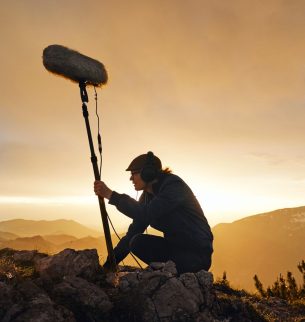
Auf den Spuren von Anton Bruckners Klanglandschaft

This is a workshop where we will move as one, listening attentively, through Anton Bruckner's acoustic walks in Linz, tracking down sounds that have long since disappeared. We will use different (special) microphones that make electromagnetic vibrations audible or can even record underwater sounds. When our expedition comes to an end, we will summarise our sonic discoveries in short compositions on the computer.
Speaker: Richard Eigner, music and sound artist
Date: 30.07. to 01.08.2024
Time: 09:00 - 12:30
Suitable age: 10-15 years
Lunch (optional) (+ 1 hour longer incl. supervision)
Please bring: a snack, drink
Deadline for registrations: 17.07.2024
Do. 01.08.24
20:00
Linz
Mariendom
domorgelsommerlinz24
ESPACE SONORE
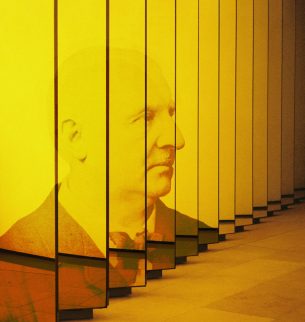
ESPACE SONORE

At domorgelsommerlinz24, in ESPACE SONORE Thierry Mechler opens up a multifaceted acoustic space featuring music from Bach to Ravel, from Bruckner to Debussy!
Admission:
Adults: pre-sales € 12.00 | Box office € 15.00 |
Young people and students (up to 27 years): pre-sales € 8.00 | Box office € 10.00 |
Children (up to 12 years): free
Cathedral Music Society Linz
Thierry Mechler | Rudigier organ
Cathedral Square 1 4020 Linz Details & Tickets
Sa. 03.08.24
19:30
Linz
Posthof
Next Bruckner - Die Konzertreihe kuratiert von Ina Regen
MYLF - Mieze Medusa & Yasmo
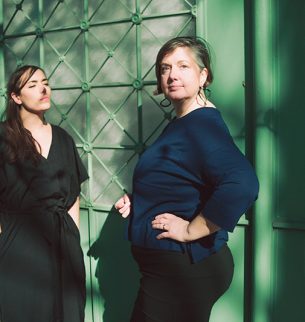
MYLF - Mieze Medusa & Yasmo

Mieze Medusa and Yasmo are "MYLF - mothers you'd like to flow with" in slam team form. The two veterans of the Austrian poetry slam scene invite you to an evening packed with language, rhythm and a change of generations. They will write, rap and speak to Bruckner inspiring laughter, reflection and participation. MYLF meet two young up-and-coming poets, providing us with a unique view from every perspective - including a look at the jubilarian!
Next Bruckner - The concert series curated by Ina Regen
11 concert evenings from January to November 2024 at Posthof Linz
Co-production: Posthof - Zeitkultur am Hafen
Ina Regen | Curation
Posthof - Zeitkultur am Hafen, Ina Regen | Co-production
Posthofstrasse 43 4020 Linz Details & Tickets
Di. 06.08.24
10:00-13:00
Linz
Direktion Kultur und Gesellschaft, Festsaal
Crash-Kurs
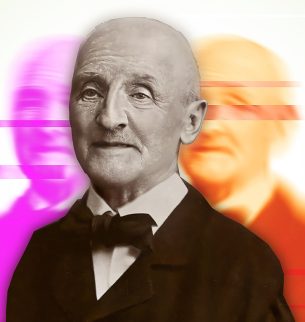
Crash-Kurs

Are you curious about Bruckner? Would you like to dive deeper into the world of the composer and the man himself? Would you like to pass on your own enthusiasm and knowledge?
Take advantage of this entertaining course offering all the music and information from and about Bruckner that it will take to expand your Bruckner horizons.
Number of participants:
The crash course will take place with a minimum of 5 participants and is restricted to 25 participants.
Promenade 37 4020 Linz Details & Tickets
So. 11.08.24
10:45
Linz
Mariendom
domorgelsommerlinz24
ERINNERUNGEN
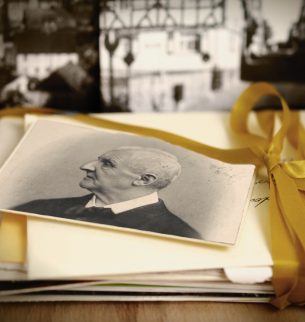
ERINNERUNGEN

MEMORIES are the focus of Andreas Etlinger's matinee concert at domorgelsommerlinz24 - with works by Anton Bruckner, Andreas Etlinger and Felix Mendelssohn Bartholdy!
Free admission!
Cathedral Music Society Linz
Andreas Etlinger | Rudigier organ
Cathedral Square 1 4020 Linz Details & Tickets
Di. 13.08.24
20:00
Linz
Arkadenhof Landhaus Linz
Serenaden
Spring String Quartet
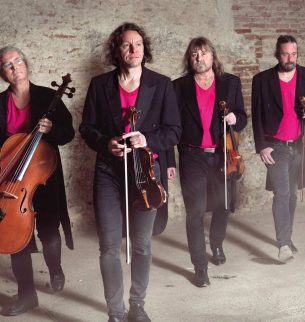
Spring String Quartet

Bruckner-Mancini-Mandelbrot
At first glance, the music of Anton Bruckner (1824-1896) and Henry Mancini (1924-1994) and the ideas of the French-American mathematician, Benoît Mandelbrot, (1924-201 0) may seem to have very little in common. In Bruckner's anniversary year, however, they have joined forces: Bruckner's sound cathedrals are subjected to the "spring string metamorphosis" using Mancini's small song formats and are viewed in the light of Mandelbrot's fractal geometry and self-similarity.
Fractals can not only be found in geometric shapes, they also occur in nature (in plant blossoms, coastlines, mountain formations, cloud shapes, river courses, etc.) and in art (the most famous example: The Great Wave off Kanagawa - a coloured woodcutting by the Japanese artist, Katsushika Hokusai). But they can also be found in music in motifs and interval sequences, in rhythm patterns in the small range and in construction patterns of large musical forms. Number combinations and ratios, in particular the golden ratio, have already played a major role in early music. This unusual programme will reveal astonishing and surprising similarities.
Spring String Quartet
Christian Wirth | Violin
Marcus Wall | Violin
Julian Gillesberger | Viola
Stephan Punderlitschek | Violoncello
Do. 15.08.24
20:00
Linz
Mariendom
domorgelsommerlinz24
BRUCKNER TODAY
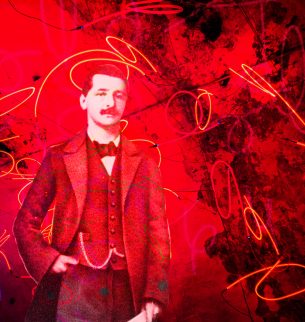
BRUCKNER TODAY

Like his predecessor, Anton Bruckner, the Cathedral organist, Wolfgang Kreuzhuber, shares a passion for improvisation - and you can hear that at the domorgelsommerlinz24 in BRUCKNER TODAY!
Admission:
Adults: pre-sales € 12.00 | Box office € 15.00 |
Young people and students (up to 27 years): pre-sales € 8.00 | Box office € 10.00 |
Children (up to 12 years): free
Cathedral Music Society Linz
Cathedral organist Wolfgang Kreuzhuber | Rudigier organ
Cathedral Square 1 4020 Linz Details & Tickets
So. 18.08.24
10:45
Linz
Mariendom
domorgelsommerlinz24
KALEIDOSKOP
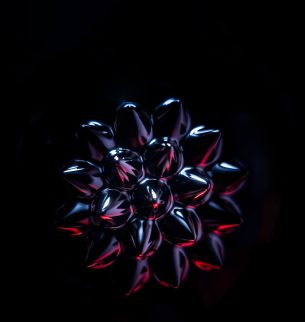
KALEIDOSKOP

In her matinée concert as part of her domorgelsommerlinz debut, Alma Teibler presents a KALEIDOSCOPE of organ music from Anton Bruckner to Petr Eben.
Free admission!
Cathedral Music Society Linz
Alma Teibler | Rudigier organ
Cathedral Square 1 4020 Linz Details & Tickets
So. 25.08.24
10:45
Linz
Mariendom
domorgelsommerlinz24
PORTRAITS
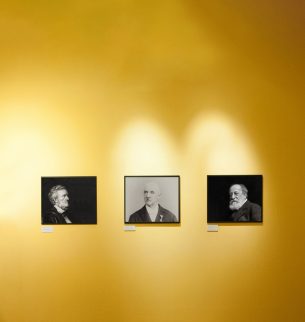
PORTRAITS

Musical PORTRAITS of Anton Bruckner, Camille Saint-Saëns and Richard Wagner are drawn by Michaela Aigner in her matinée concert at domorgelsommerlinz24.
Free admission!
Cathedral Music Society Linz
Michaela Aigner | Rudigier organ
Cathedral Square 1 4020 Linz Details & Tickets
Do. 29.08.24
20:00
Linz
Mariendom
domorgelsommerlinz24
BRUCKNER AT NIGHT
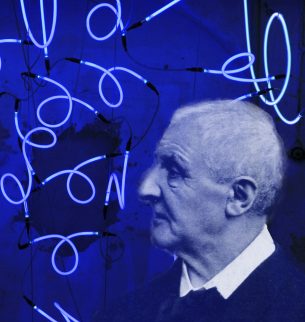
BRUCKNER AT NIGHT

Lilo Kunkel sets the musical tone when it is time for BRUCKNER AT NIGHT! There is music and rhythm at domorgelsommerlinz24 in the Mariendom - from Anton Bruckner to Cole Porter!
Admission:
Adults: pre-sales € 12.00 | Box office € 15.00 |
Young people and students (up to 27 years): pre-sales € 8.00 | Box office € 10.00 |
Children (up to 12 years): free
Cathedral Music Association Linz & Mariendom Linz
Lilo Kunkel | Rudigier organ
Cathedral Square 1 4020 Linz Details & Tickets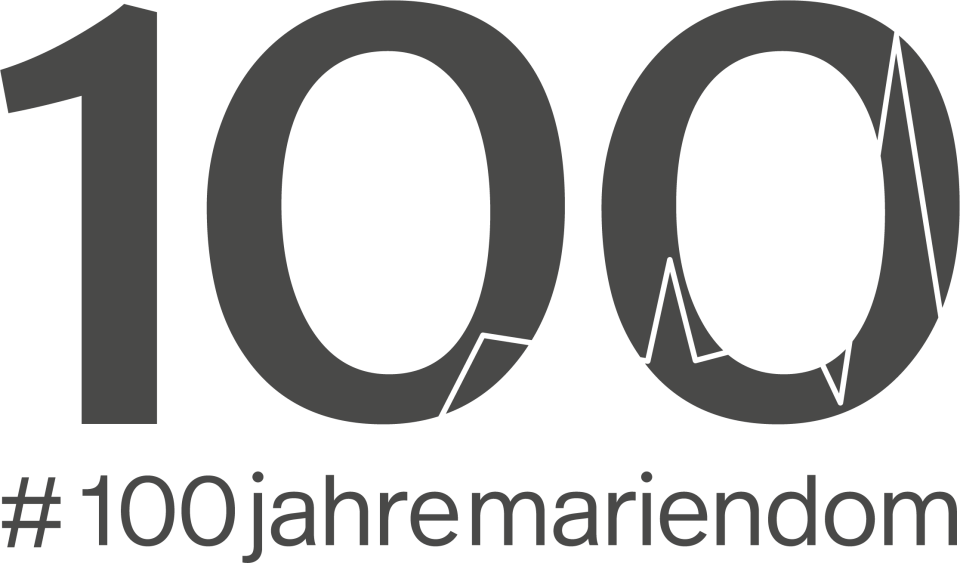
Further dates in the series
So. 01.09.24
bis Mo. 30.09.24
Uhrzeit folgt!
Linz
Mariendom
Further dates
Anton Bruckner: eine HerStory
Für Theresia.

Für Theresia.

This focus of this project lies on ten women who played a vital role in the life of Anton Bruckner. Linz-based artist Zoe Goldstein spent over a year collecting information in order to compile these biographies. The aim is to cast the spotlgiht on these women and gain an idea of who they were and how they lived. Portraits and biographies are examined allowing us to question the role of women in society then and now. The title of the project links the importance of women to his art and refers to his mother, Theresia Bruckner, who was an important female constant in his life. To give a wider audience access to this topic and generate a discourse, this project has been conceived as a travelling exhibition in Linz, Steyr and Attersee. An additional item of the programme, following the opening in the Brucknerhaus on International Women's Day, is a production with a concert and a reading which will take place in the last month of the presentation at the square of the Mariendom (St. Mary's Cathedral).
11.03. to 01.04.2024 | Linz, Ernst-Koref-Promenade, meadow in front of the Brucknerhaus
02.04. to 30.04.2024 | Linz, Ars Electronica Centre
02. 05 to 28.05.2024 | Linz, Arkadenhof in the Landhaus | accessible for those with impaired mobility
June & July 2024 | Steyr, Werndlpark, Handel-Mazzetti-Promenade |
August 2024 | Attersee | accessible for those with impaired mobility
September 20 24 | Linz, Mariendom (St.Mary's Cathedral)
A project of the Upper Austrian KulturEXPO Anton Bruckner 2024 with the kind support of the Federal Ministry of Arts, Culture, the Civil Service and Sport and the City of Linz / Linz Kultur
Zoe M. Riess aka Zoe Goldstein | idea, concept, stage direction
Friedrich Buchmayr (Textual, author of "Mensch Bruckner", St. Florian Abbey), Poxrucker Sisters, Elena Pierini (choirmaster of the Linz State Theatre) | Project participants
Lower Donaulände 7 4010 Linz Details & Tickets





Mo. 02.09.24
10:00-13:00
Linz
Direktion Kultur und Gesellschaft, Festsaal
Crash-Kurs

Crash-Kurs

Are you curious about Bruckner? Would you like to dive deeper into the world of the composer and the man himself? Would you like to pass on your own enthusiasm and knowledge?
Take advantage of this entertaining course offering all the music and information from and about Bruckner that it will take to expand your Bruckner horizons.
Number of participants:
The crash course will take place with a minimum of 5 participants and is restricted to 25 participants.
Promenade 37 4020 Linz Details & Tickets
Mi. 04.09.24
Uhrzeit folgt!
Linz
Ignatiuskirche - Alter Dom
Bruckner Improvised
Brucknergeburtstag
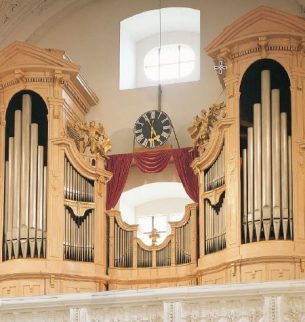
Brucknergeburtstag

With its authentic organ, the Old Cathedral in Linz is the best place to celebrate Bruckner's birthday as a master of improvisation with this very genre.
Throughout the day, national and international organists will bring the original Bruckner organ to life with their improvisations.
An event of the Brucknerbund for Upper Austria
Domgasse 3 4020 Linz
Further dates in the series
Mi. 04.09.24
00:00-04:00
Linz
Mariendom
Further dates
Eine Klanginstallation zwischen dem Dom zu Notre Dame und den Eishöhlen am Dachstein
Silent Echoes: Dachstein.

Silent Echoes: Dachstein.

Notre Dame is known as the soul of Paris. One whole country identifies with this church. The tragic fire of 2019 silenced the church bells but they were not damaged by the fire and they continue to listen secretly and silently to the sounds of the City surrounding Notre Dame. Silent Echoes: Notre Dame is a continuously live-streamed sound sculpture which lends a voice to the simple physical fact that these bells are constantly ringing in secret. The American sound artist, Bill Fontana, is expanding his artistic project for the 2024 Capital of Culture in collaboration with the Centre Pompidou in Paris, the Parisian-based IRCAM Research Institute for Acoustics, the Upper Austrian KulturEXPO Anton Bruckner 2024, the Ars Electronica Festival and the Goiserer Musiktage (Goiserer Days of Music) to create a "dialogue" between the glacial caves of the Dachstein and Paris. The sound of the melting glacier and the resonanting ring of the bells of Notre Dame create a duet which tells the tale of a European cultural monument that almost disappeared and a natural world that equally risks disappearing. Bill Fontana describes this extended version, in which the sounds of the glacier are "played back" live to Paris, as an artistic statement about the consequences of climate change.
The "Parzival" Cathedral in the ice caves of the Dachstein is a place that holds an "invaluable secret", as Anton Bruckner's composition Locus iste puts it: a secret that asks us humans how we want to live with nature in the future. In addition, OÖ KulturEXPO Anton Bruckner 2024, in cooperation with the Goiserer Musiktage, will award a composition commission to young composers on this theme. The work will be premiered as part of the European Capital of Culture 2024 at the Goiserer Musiktage on the grand piano of glass in the ice cave.
Opening and live broadcast as part of the Ars Electronica Festival and 24-hour birthday party
Free admission!
Accessibility:
Mariendom Linz
A project of the European Capital of Culture Bad Ischl-Salzkammergut 2024 in cooperation with IRCAM, Centre Pompidou, OÖ KulturEXPO Anton Bruckner 2024, Ars Electronica Festival, Goiserer Musiktage, Kunstradio Ö1. thanks to: OÖ Seilbahnholding GmbH, Planai-Hochwurzen Bahnen GmbH
With the support of: Institut français d'Autriche
Bill Fontana | Artist
Wolfgang Schlag | Curator
Peter Brugger | Co-Curator, Project Manager Goiserer Musiktage (Goiserer Days of Music)
Christian Haselmayr | Programme Director of Music, Youth, Community Building
Herrenstrasse 26 4020 Linz Details & Tickets
Mi. 04.09.24
ganztägig
Ansfelden, Linz, St. Florian
Ein Fest für Anton Bruckner, ein Feiertag für Oberösterreich
„Happy Birthday, Anton!“
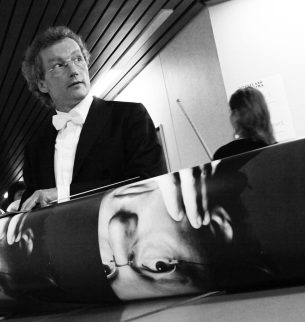
„Happy Birthday, Anton!“

A concert for Bruckner's 200th birthday in Ansfelden. Since 2018, the International Bruckner Festival Linz has commenced every year on 4 September, the birthday of its namesake. The birthday concert to kick off the festival always takes place in Ansfelden, the place where it all began for Anton Bruckner: it was here that he was born in the servants' quarters of the school building and where he was baptised on the very same day in the neighbouring parish church.
In 2024, the well-wishers are prominent to say the least: The Cleveland Orchestra, known as the "most European" of the US orchestras, and its chief conductor, Franz Welser-Möst, who hails from Linz, will do the honours and pay tribute to the jubilarian with an open-air performance in the area between the parish church and the courtyard.
Accessible to those with impaired mobility:
Brucknerhaus
Franz Welser-Möst | Conductor
The Cleveland Orchestra | Conductor
Details & TicketsFurther dates in the series
Mi. 04.09.24
Uhrzeit folgt!
Linz
Mariendom
Further dates
Bruckner x Pop x No Wave
NoFive

NoFive

The striking similarity between a recurring theme from Bruckner's Fifth Symphony and a guitar riff by the White Stripes - in their song, the Seven Nation Army - is the godmother of this ten-piece electric guitar ensemble. In this field of tension between high culture, popular culture and avant-garde, the collective dedicates itself to this very riff. In essence, this is less a case of "stealing the stolen" or an act of appropriation but rather a recuperation. Experimental acoustic spaces encounter incisive repetitions of the Bruckner riff in variations and with subtle shifts. The result is a a monstrous sound aesthetic, a hybrid of Anton Bruckner, the White Stripes and the loud electric guitar symphonist, Glenn Branca.
The concert takes place as part of the Ars Electronica Festival.
Another local event tip: BruQner.
Details at www.nofive.org
Accessibility:
Accessibility: Limited wheelchair accessibility, assistance required in some cases
Free admission!
A project of the Upper Austrian KulturEXPO Anton Bruckner 2024.
NoFive
Kristina Hofer | Guitar
Gabriele Kepplinger | Guitar
Leona Sperrer | Guitar
Dominique Berger | Guitar
Lina Gärtner | Guitar
Johanna Forster | Guitar
Andre Zogholy | Guitar
Samy Zogholy | Guitar
Florian Graf | Guitar
Christoph Fizl Hehn | Drums
Wolfgang Fuchs | Bass
Marc Reibel | Conductor
Cathedral Square 1 4020 Linz
Mi. 04.09.24
05:00-09:00
Linz
Ignatiuskirche - Alter Dom
Bruckners Erwachen – ein improvisiertes Orgelfrühstück

Bruckners Erwachen – ein improvisiertes Orgelfrühstück

Today, the Bruckner organ in the Old Cathedral presents itself as an authentic Bruckner monument, unique in its kind. Renowned organists such as Jürgen Natter - Dornbirn (A), Jörg Abbing - Saarbrücken (D), Monica Melcova - Granada (E), Ludwig Lusser - St. Pölten (A) and Bernhard Prammer - Linz (A) will demonstrate their improvisation skills on the Bruckner holiday. Guests can also expect coffee and croissants.
Free admission!
A project of the Upper Austrian KulturEXPO Anton Bruckner 2024 in cooperation with the Bruckner Association for Upper-Austria (Brucknerbund für Oberösterreich)
Domgasse 3 4020 Linz
Mi. 04.09.24
16:00
Linz, Steyr
Stadtmuseum Steyr
Lorem ipsum dolor sit amet
Steyr – wo ich alljährlich so gerne weile

Steyr – wo ich alljährlich so gerne weile

Steyr was one of Bruckner's favourite towns. The town museum is dedicating the special exhibition "UN#ERHÖRT dieser Bruckner!" to the life and work of Anton Bruckner, with a focus on his relationship with Steyr. Bruckner, the man, is on display and interactive music installations introduce visitors to unknown worlds of sound. In the old sexton's house located next to the parish church, Wolfgang Hack has created a show entitled "Anton Bruckner in Steyr - Where I enjoy staying every year", which showcases the composer's life and the history of the period.
The curators, Martin L. Fiala and Wolfgang Hack, will guide visitors through the exhibitions in the town museum and the sexton's house. Bruckner cider can also be tasted.
Free admission!
A project of the Town Museum of Steyr and the sexton's house
Grünmarkt 26 4400 Linz, Steyr Details & Tickets
Mi. 04.09.24
19:00-21:00
Ansfelden, Linz
Donaupark
Geburtstagskonzert The Cleveland Orchestra, Franz Welser-Möst

Geburtstagskonzert The Cleveland Orchestra, Franz Welser-Möst

"Happy birthday, Anton!" Since 2018, the International Bruckner Festival Linz has commenced every year on 4 September which marks the birthday of its namesake. The birthday concert to kick off the festival always takes place in Ansfelden, the place where everything began for Anton Bruckner. It was here that he entered the world in the school's official residence and was baptised on the same day in the nearby parish church. In 2024, the well-wishers are prominent to say the least: The Cleveland Orchestra and its chief conductor, Franz Welser-Möst, from Linz will do the honours and pay tribute to the jubilarian with an open-air performance next to the parish church.
Anton Bruckner:
Symphony No. 4 (Romantic) in E flat major, WAB 104, "1878/80 version"
ANSFELDEN - Open-air stage next to the parish church
presented by Raiffeisenlandesbank Oberösterreich
(already sold out)
LINZ - Live broadcast in the Danube Park
powered by LINZ AG
Free admission!
A project by INTERNATIONAL BRUCKNERFEST LINZ 2024
The Cleveland Orchestra
Franz Welser-Möst
Mi. 04.09.24
22:00-23:00
Linz
Mariendom
im Rahmen von Ars Electronica Festival und 24-Stunden-Geburtstagsfest
BruQner – The Sound of Entanglement
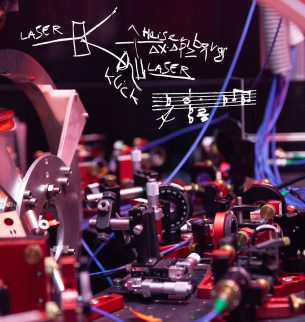
BruQner – The Sound of Entanglement

The second quantum revolution as a musical spectacle in St. Mary's Cathedral (Mariendom) in Linz:
Lasers, mirrors, polarisers, non-linear crystals - an experimental set-up from the high-tech lab in the middle of the Mariendom (St. Mary's Cathedral) in Linz. Entangled photons - the quanta of light - become the conductors and direct Bruckner's Perger Prelude in a way no human being in the world could manage.
Two resounding church organs play live music filling the sensational acoustic space of the Cathedral. BruQnerprovides us with a new perspective of our reality - a world premiere!
Notes on the event:
- The event will be held in English on this day!
- Use of fog fluids!
Accessible for those with impaired mobility:
Limited wheelchair access, some assistance is required.
Free admission!
A project of the Upper Austrian KulturEXPO Anton Bruckner 2024 in cooperation with Ars Electronica and with the kind support of LIT-JKU, VCQ, the University of Innsbruck, TU Wien, SFB - beyondC and the Cultural department of the City of Vienna.
Clemens Wenger | musical direction
Enar de Dios Rodríguez | Artist, visual design
Martin Ringbauer | exp. physicist, University of Innsbruck
Johannes Kofler | theor. computer science, JKU
Richard Küng | theor. computer science, JKU
Alexander Ploier | theor. computer science, JKU
Benjamin Orthner | exp. physicist, TU Vienna
Philipp Haslinger | exp. physicist, TU Vienna, Project Management
Wolfgang Kreuzhuber | Organist
Gerhard Raab | Organist
Cathedral Square 1 4020 Linz Details & Tickets






Mi. 04.09.24
22:00-24:00
Linz
Mariendom
Ars Electronica Opening im Mariendom

Ars Electronica Opening im Mariendom

The end of the birthday brings us to three outstanding sound events in the Mariendom. For this Bruckner created his locus iste: quantum revolution as a musical spectacle, Bruckner's Seventh as chamber music & a 12-piece electric guitar ensemble.
Ars Electronica 2024 will take place in Linz from September 4 to 8 and is dedicated to the title HOPE - who will turn the tide. The Ars Electronica Opening will be celebrated in the Mariendom from 22:00 - 24:00.
BruQner - The Sound of Entanglement (22:00): The second quantum revolution as a musical spectacle. Entangled photons - the quanta of light - become conductors and direct Bruckner's Perger Prelude in a way that no human being in the world could. Two resounding church organs play live and fill the spectacular sound space of the cathedral.
Chamber musicians of the Bruckner Orchestra Linz ( 23:00) play 2 movements of Bruckner's arrangement of Symphony No. 7 for ensemble (Schönberg version): 2nd movement: Adagio. Very solemn and very slow / 3rd movement: Scherzo. Very fast.
NoFive - Bruckner x Pop x No Wave (23:30): A fusion of Bruckner's Fifth Symphony and the White Stripes' iconic "Seven Nation Army" riff, shaken and stirred Glenn Branca style. A mighty wall of guitar amps reinforces the 12-piece ensemble, which symphonizes an avant-garde soundscape between high and pop culture.
Free admission!
A project of the Upper Austrian KulturEXPO Anton Bruckner 2024 in cooperation with Ars Electronica and with the kind support of LIT-JKU, VCQ, the University of Innsbruck, TU Wien and the City of Vienna Department of Culture.
Cathedral Square 1 4020 Linz
Do. 05.09.24
17:00
Linz
Innenstadt Linz
Internationales Brucknerfest Linz 2024
Bruckner aus dem Stegreif
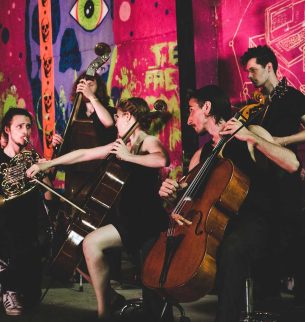
Bruckner aus dem Stegreif

Flash mobs and pop-up concerts
Since 2018, the consistently implemented conceptual and programmatic reorientation of the International Bruckner Festival Linz has been accompanied by a return to its namesake and a clear commitment to this composer, whose work has never been regarded as the museum content of the festival, but always as the subject of a lively debate. The series of events with (pop-up) concerts, sound installations and performances established in 2019, which took place on the 'bridge days' between the birthday concert on 4 September and the official opening week, contributed to this. September and the official opening weekend of the Brucknerfest made a valuable contribution to this by providing low-threshold access to a contemporary artistic approach to Anton Bruckner or the respective festival theme beyond the concert hall, in the middle of the city center, with free admission, which was mostly presented for discussion in public spaces.
In the anniversary year 2024, the Stegreif Orchester will bring the Bruckner Festival and the music of the birthday boy into the city on 5 and 6 September. It will deliver what its name promises: excerpts from Bruckner's works will be performed as part of flash mobs and pop-up concerts, modified and adapted in a creative manner and enriched with improvisational elements and, of course, always played off the cuff. For two days Bruckner's music will be omnipresent in the streets and squares of Linz, in the lobby area of the station as well as in churches and museums, true to the motto "200 years and not in the least bit quiet".
Arrangements of and improvisations on works by
Anton Bruckner (1824-1896)
Stegreif - The Improvising Symphony Orchestra
Free admission (free numbered tickets are required)
Do. 05.09.24
18:00
Linz
OÖ Kulturverein im OÖ Kulturquartier
Further dates
Eröffnung
WhatsAB
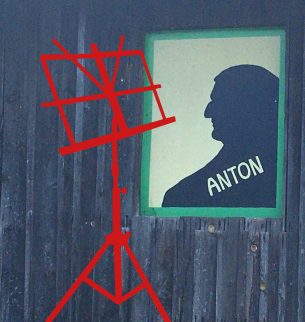
WhatsAB

In the autumn of 2023, WhatsAB will initially be a live event for the public, naturally transient as such, based on an idea by Rainer Zendron and Bernd Preinfalk. A year later, in the fall of 2024, the sound event will become an installation for an art space.
Conducted by Sigurd Hennemann, an ensemble of about twenty musicians will play a corresponding arrangement of the Andante in E minor from Three Movements for the Orchestra which is recorded in Anton Bruckner's catalogue raisonné as number 97. As befits the digitally networked age, the individual musicians are related to each other, but record their respective parts as solos at a different Bruckner location. The camera and microphone focus on the musicians without blocking out any background or ambient noise.
The sum of these parts and the orchestral concert are only added up in the media installation in a continuous loop: twenty screens on just as many music stands showcase the musicians playing in the public space; the conductor, Hennemann, can be seen at work on a monitor on the wall. The Andante itself can be heard as a professional mix of the individual recordings. The visitors are free to move around the room as they wish in this atmosphere.
Exhibition period:
05.09. - 04.10.24
Accessibility:
+43 (0) 732772052502
info@ooelkg.at
A project of the Upper Austrian KulturEXPO Anton Bruckner 2024
Rainer Zendron, Bernd Preinfalk | Overall Concept
Sigurd Hennemann | Conductor
Country road 31 4020 Linz Details & Tickets
Do. 05.09.24
20:00
Linz
Mariendom
domorgelsommerlinz24
RAUMKLANG#25
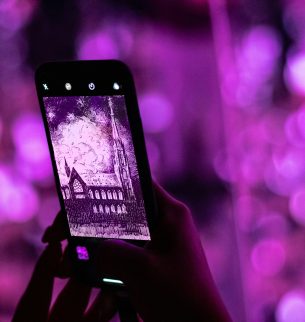
RAUMKLANG#25

Endless anniversaries: 200 years of Anton Bruckner, 100 years of the Mariendom (New Cathedral) and 25 years of Raumklang - harps, horns, clarinets and organs will help to celebrate this in style at domorgelsommerlinz24 with RAUMKLANG#25!
Free admission!
(ticket reservations are requested)
Cathedral Music Society Linz
Clarinet ensemble of the Anton Bruckner Private University
Virtuoso harpists
Vienna Horn Ensemble
Cathedral organist Wolfgang Kreuzhuber | Rudigier organ and choir organ
Gerhard Raab | Rudigier organ and choir organ
Cathedral Square 1 4020 Linz Details & Tickets
Fr. 06.09.24
Linz
Ursulinenhof
Further dates
Ausstellung
WhatsAB

WhatsAB

In the autumn of 2023, WhatsAB will initially be a live event for the public, naturally transient as such, based on an idea by Rainer Zendron and Bernd Preinfalk. A year later, in the fall of 2024, the sound event will become an installation for an art space.
Conducted by Sigurd Hennemann, an ensemble of about twenty musicians will play a corresponding arrangement of the Andante in E minor from Three Movements for the Orchestra which is recorded in Anton Bruckner's catalogue raisonné as number 97. As befits the digitally networked age, the individual musicians are related to each other, but record their respective parts as solos at a different Bruckner location. The camera and microphone focus on the musicians without blocking out any background or ambient noise.
The sum of these parts and the orchestral concert are only added up in the media installation in a continuous loop: twenty screens on just as many music stands showcase the musicians playing in the public space; the conductor, Hennemann, can be seen at work on a monitor on the wall. The Andante itself can be heard as a professional mix of the individual recordings. The visitors are free to move around the room as they wish in this atmosphere.
Opening:
September 05, 2024, 18:00
Opening hours:
Mon - Fri: 08:00-19:00
SAT: 10:00-17:00
Accessibility:
+43 (0) 732772052502
info@ooelkg.at
A project of the Upper Austrian KulturEXPO Anton Bruckner 2024
Rainer Zendron, Bernd Preinfalk | Overall Concept
Sigurd Hennemann | Conductor
Country road 31 4020 Linz Details & Tickets
Fr. 06.09.24
16:00
Linz
Mariendom
im Rahmen von Ars Electronica Festival
BruQner – The Sound of Entanglement

BruQner – The Sound of Entanglement

The second quantum revolution as a musical spectacle in St. Mary's Cathedral (Mariendom) in Linz:
Lasers, mirrors, polarisers, non-linear crystals - an experimental set-up from the high-tech lab in the middle of the Mariendom (St. Mary's Cathedral) in Linz. Entangled photons - the quanta of light - become the conductors and direct Bruckner's Perger Prelude in a way no human being in the world could manage.
Two resounding church organs play live music filling the sensational acoustic space of the Cathedral. BruQnerprovides us with a new perspective of our reality - a world premiere!
Notes on the event:
- The event will be held in German on this day!
- Use of fog fluids!
Accessible for those with impaired mobility:
Limited wheelchair access, some assistance is required.
Free admission!
A project of the Upper Austrian KulturEXPO Anton Bruckner 2024 in cooperation with Ars Electronica and with the kind support of LIT-JKU, VCQ, the University of Innsbruck, TU Wien, SFB - beyondC and the Cultural department of the City of Vienna.
Clemens Wenger | musical direction
Enar de Dios Rodríguez | Artist, visual design
Martin Ringbauer | exp. physicist, University of Innsbruck
Johannes Kofler | theor. computer science, JKU
Richard Küng | theor. computer science, JKU
Alexander Ploier | theor. computer science, JKU
Benjamin Orthner | exp. physicist, TU Vienna
Philipp Haslinger | exp. physicist, TU Vienna, Project Management
Wolfgang Kreuzhuber | Organist
Gerhard Raab | Organist
Details & Tickets






Further dates in the series
@ Sonnenstein Loft (Linz)
@ Holy Hydra Linz (Linz)
@ Holy Hydra Gmunden (Gmunden)
Fr. 06.09.24
19:00
Linz
Stadtpfarrkirche Urfahr
Further dates
Elektronisches Orgelkonzert, Bruckner‘s Sound Remixes & Sound Installation & Performance
Bruckner’s Beats
@ Holy Hydra Linz
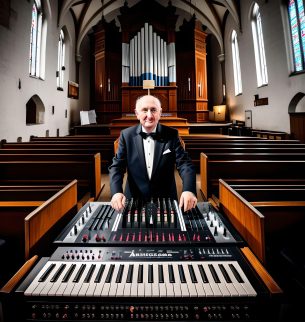
Bruckner’s Beats
@ Holy Hydra Linz

Bruckner as part of the club scene? In April, the STREAM CLUB and students from the state music school studying digital music production proved that this is possible. And the beat goes on: "This all began with the idea to generate new approaches to Anton Bruckner's classical music," Ilona Roth from Transitheart Productions explains. The latter is a label for artistic productions in the field of contemporary dance and theatre with interfaces to performance art, film and video. Together with the Linz-based collective Holy Hydra, she devised Bruckner's Beats and presents pieces by Bruckner featuring electronic remixes and new arrangements in a club atmosphere. Sound installations, performances, art happenings and interventions - thus Anton Bruckner becomes danceable and tangible.
"For half a decade now we have been dancing at the interface of club culture, religion and society due to a fascination for special places and a passion for techno. Our spherical sounds and hard beats cast a spell on holy architecture. Sacred space meets urban space, bumbum comes face to face with certain standards," this is how the members of the Hydra collective describe themselves.
The many-headed creature from the underworld of Linz, which defends subcultures both by day and by night, was founded in 2016 as the event collective die geile Hydra which has since become a cultural association. Since 2018 Hydra, as Holy Hydra , has been playing in churches. For example, on 6 and 7 September, 2024 in the parish church in Urfahr.
Bruckner's Beats as part of Holy Hydra.
A project of the Upper Austrian KulturEXPO Anton Bruckner 2024
Transitheart Productions coop Holy Hydra
Clemens Riedl | Organ; E:K:V
Stefan Weissenberger | trumpet & electronics; E:K:V
Björn Büchner | Electronics; E:K:V
Audiomojo | Sound Remixes
LynnMayya | Sound Remixes
Reinhard Reisenzahn | Sound Remixes
Lilli Jungin Lee | Lee Jung In Creation - dance performance
Seo Jin Moon | Lee Jung In Creation - dance performance
Yeram Kand | Lee Jung In Creation - dance performance
Seung Ju Lee | Lee Jung In Creation - dance performance
Schulstraße 4 4040 Linz




Fr. 06.09.24
20:00
Linz
Posthof
Next Bruckner - Die Konzertreihe kuratiert von Ina Regen
Violetta Parisini Trio & Wim

Violetta Parisini Trio & Wim

Violetta Parisini opens up a world of emotion in her songs. Emotions wihich we all know although we have not yet formulated them into words. Peter Rom accompanies here on the guitar, his unique sound is enchanting, and Hanibal Scheutz on bass, personifies the groove. Parisini weaves a magic carpet that will remain soft and warm in your memory for a long time to come. The indie pop artist, Wim, made a name for herself in 2022 with the release of her debut album "Boxer". Her songs, which shine with poetry, accurate lyrics and a love of melancholy, are never simple, but always full of lightness.
The two artists got to know each other while writing their duet "Gespenster" at a songwriting camp and have since written a few more songs out of sheer enthusiasm for each other, which will be performed this evening at the Posthof. German indie pop with no clichés or compromises.
Next Bruckner - The concert series curated by Ina Regen
11 concert evenings from January to November 2024 at Posthof Linz
Co-production: Posthof - Zeitkultur am Hafen
Ina Regen | Curation
Posthof - Zeitkultur am Hafen, Ina Regen | Co-production
Posthofstrasse 43 4020 Linz Details & Tickets
Sa. 07.09.24
20:30
Linz
Donaupark
Internationales Brucknerfest Linz 2024
Linzer Klangwolke 24
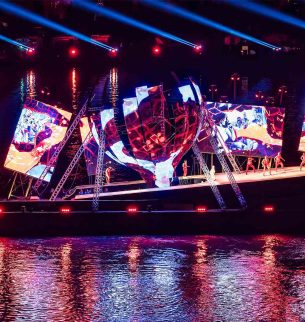
Linzer Klangwolke 24

Linzer Klangwolke 24
presented by SPARKASSE OÖ & LINZ AG
The success story of the Linz Klangwolke began 45 years ago, on 18 September, 1979, at 8 p.m. sharp, with Anton Bruckner's Symphony No. 8 in C minor. Back then, people placed their radios at open windows and listened as Bruckner's music rang through the streets and resounded throughout the entire city like the eponymous Klangwolke. Since then, the magic of this major event, which has segued to become an audiovisual, mass media event of international appeal, has enchanted more than three and a half million spectators. Once a year Linz's Danube Park, as well as the river itself and its banks, are transformed becoming a brilliantly illuminated and sonorous venue especially adapted to the open-air conditions.
In 2023, Francesca Zambello created a sensationally successful sound cloud with ODYSSEY. A Journey Through Worlds that attracted more than 100,000 spectators and listeners. Who will follow in her footsteps in the Bruckner year 2024 and thus join the long list of renowned artists from a wide variety of genres who have shaped the Linz Klangwolke over the past four and a half decades, including most recently the theatre collective, La Fura dels Baus, and directorial greats such as David Pountney, Pierre Audi and Robert Dornhelm. The secret will not be revealed until the early summer. What is already certain, however, is that this highlight in the city's cultural calendar, which is one of Europe's largest and most spectacular outdoor productions in public spaces, will be presented as usual by SPARKASSE OÖ and LINZ AG, with the latter once again inviting all visitors to continue celebrating together at the Nachklangwolke.
So. 08.09.24
10:30
Linz
Brucknerhaus Linz
Feierliche Eröffnung des Internationalen Brucknerfestes Linz 2024
Festakt 2024
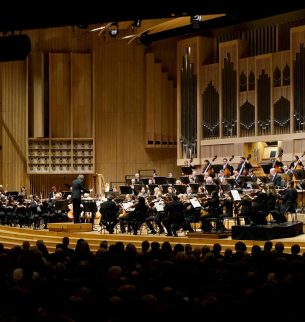
Festakt 2024

Ceremonial opening of the International Bruckner Festival Linz 2024
As usual the hymns that open the ceremony will be followed by the Bruckner hymn. This was composed by Wilhelm Floderer in 1894 and performed for the first time when the memorial plaque at Bruckner's birthplace in Ansfelden was unveiled on 12 May 1895 accompanied by the Liedertafel "Frohsinn" (choir), of which he was choirmaster at the time.
One can hear all of the early orchestral works written by the composer himself which were composed during his apprenticeship with the Linz theatre conductor, Otto Kitzler. This lasted from autumn 1861 to summer 1863 and ended with the composition of the "Study Symphony" in F minor. Although they still bear traditional traits, they already strike an individual note and portray their creator at the crossroads between an existence as a composer of functional music for everyday use and an existence as a symphonist. As is well known, Bruckner decided to take the latter path, even if it turned out to be a much rockier one.
The program also pays tribute to him as a symphonist, albeit with a twinkle in his eye, as the composer declared that this was his "life's work": The commissioned work InstAnt on looks back to the future and, following the motto "Bruckner's complete symphonies (slightly shortened)", roams through his eleven contributions to the genre in eleven minutes, adapting, arranging, spinning on, eavesdropping, rethinking, alienating and quoting. Who would be better suited to take on this challenge with as much fun and humour as Johannes Berauer, who was born in Wels and specializes in overcoming the boundaries between classical avant-garde, jazz and world music? And who would be more knowledgeable interpreters of such a piece than the Bruckner specialists of the orchestra named after him and its chief conductor?
Wilhelm Floderer (1843 -1917)
Bruckner Hymne in C major for a mixed choir a cappella (1894)
Anton Bruckner (1824 - 1896)
Overture in G minor, WAB 98 (1862-63)
March in D minor, WAB 96 (1862)
Three orchestral pieces in E flat major, E minor and F major, WAB 97, Nos. 1-3 (1862)
Johannes Berauer (* 1979)
InstAnt on for the orchestra (2023-24) [world premiere]
Chorhaus Frohsinn:
Linzer Singakademie (Singing Academy of Linz)
Hard-Chor Linz
Hard-Chor TNG - The New Generation
Bruckner Orchestra Linz
Markus Poschner | Conductor
So. 08.09.24
10:45
Linz
Mariendom
domorgelsommerlinz24
FINALE
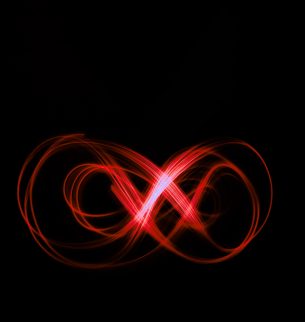
FINALE

Gerhard Raab's matinée concert at domorgelsommerlinz24 revolves around Bruckner's 200th birthday - with the finale from Bruckner's 8th Symphony!
Free admission!
Cathedral Music Society Linz
Gerhard Raab | Rudigier organ
Cathedral Square 1 4020 Linz Details & TicketsFurther dates in the series
So. 08.09.24
14:00-17:30
Linz
Donaupark
Further dates
Ein Orgelspielplatz zu Anton Bruckner
SCHORGEL
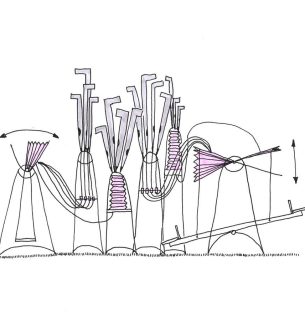
SCHORGEL

The installation by the artist, Clemens Bauder, combines organ playing and an ensemble of newly built playground equipment to create a collective musical instrument in a public space. Different organ pipes are operated by swinging and rocking them together - an acoustic space develops in the organ playground making Anton Bruckner (on the occasion of the 200th anniversary of his birth) audible and bringing him to life in both an abstract and playful manner.
The modular SCHORGEL will be set up in 2024 in various Upper Austrian locations with a Bruckner connection as well as at the Upper Austrian summer retreat in Vienna.
STARTING POINT
The history of the SCHORGEL begins with the Bruckner organ and its supply of air in the Old Cathedral in Linz. Anton Bruckner worked as a cathedral organist for thirteen years from 1855. In this time he had the organ adapted in several stages to match his own ideas. As was customary at the time, the air or wind supply to the organ was ensured by a bellows pedal (bellows pedal). To do this, the bellows were drawn up and pressed together by the feet and the entire body weight of the assistant. Before air is blown into the organ pipes, it is collected in a magazine bellows for a continuous supply. This physical momentum of constantly kicking and drawing up the bellows forms the starting point for the artistic work of the "SCHORGEL".
MAKING MUSIC WITH ONE'S WHOLE BODY
If you observe the use of seesaws in playgrounds, the movements can be compared to the activity of bellows treaders. The up and down motion of the seesaw is reminiscent of the alternating pulling up and squeezing together of a scoop. Based on this playful translation of rocking and swinging movements into an air supply for various pipe stops, a collectively operable organ instrument is created. By using several rocking and swinging devices with bellows of different sizes, a soundscape is created in which certain sound modulations only arise through the joint action and reaction to the actions of the other rockers or swingers. It is a game on a collective organ in which all of the participants have to coordinate their actions with those of the others. Experimenting with different rocking or swinging speeds - from the gentle rocking back and forth on a swing to the powerful push-off on the high seesaw - determines the air supply and the ever-changing composition that fills the immediate surroundings with sound.
ABOUT THE ARTIST
Clemens Bauder
(*1986 in Linz, lives and works in Linz) studied architecture at the University of Art in Linz and works in the fringe areas of architecture, art and installation. His works range from usable sculptures to experimental spatial installations.
The SCHORGEL is coming to Linz!
The organ playground can be experienced as part of the: KINDERKLANGWOLKE 24
A project of the Upper Austrian KulturEXPO Anton Bruckner 2024 with the kind support of the Federal Ministry for Arts, Culture, the Civil Service and Sport.
Studio Clemens Bauder | Idea, concept, realisation
Danube Park 4020 Linz
So. 08.09.24
14:30
Linz
Donaupark
Internationales Brucknerfest Linz 2024
Kinderklangwolke 24
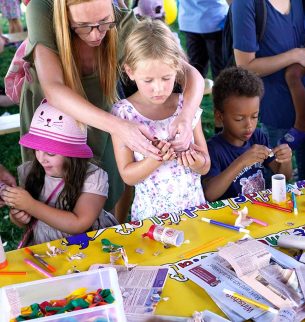
Kinderklangwolke 24

A fun and hands-on experience for both the young and old in the Danube Park!
presented by SPARKASSE OÖ & LINZ AG
Organised and developed by Kuddelmuddel, the children's centre of culture, the children's cloud of sound (Kinderklangwolke) combines attractive offers that invite you to become active yourself. It offers a colourful and entertaining stage programme specially rehearsed for this event: an unbeatable combination that has long since made the children's cloud of sound a popular cultural event for the family as a whole.
The Kinderklangwolke 23 was given the title Little which delighted, fascinated and captivated over three thousand visitors. In Susanne Stemmer's production, the story, based on the series of children's book with the same name, was filled with suspense right up to the very end. It also did away with classic role clichés in a delicate but always pointed manner. Twenty children between the ages of 8 and 14 who were enthusiastic about singing and acting let their voices resound throughout the Danube area presenting songs with a catchy tune quality. Berlin singer-songwriter, Suli Puschban, and her band, Die Kapelle der guten Hoffnung, chipped in with rocking melodies that invited the audience to sing, dance and celebrate with them in front of the large open-air stage.
Once again in the Bruckner year 2024, young visitors will again be able to enjoy a relaxed atmosphere in the Danube Park near the Brucknerhaus Linz and take part in a varied musical and cultural experience with family members of all generations. Numerous food and drink stations as well as a variety of hands-on activities round off the programme of this popular family event in Linz.
14:30 Admission, opening of creative stations, joint warm-up, street food
16:00 Programme
17:00 End
Free admission!
So. 08.09.24
18:00
Linz
Brucknerhaus Linz
Internationales Brucknerfest Linz 2024
Stegreif Orchester #freebruckner
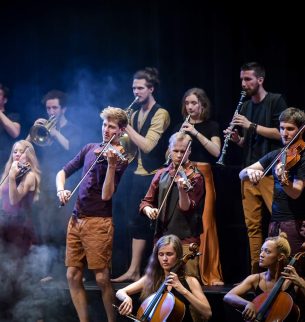
Stegreif Orchester #freebruckner

#freebruckner
The goal of Stegreif - The Improvising Symphony Orchestra - is to show visitors what a contemporary orchestra can (also) look like. The international musicians join symphonic music with improvisation and the influences from other musical genres in radical recompositions and get the audience involved in original concepts of space.
On the occasion of the 200th anniversary of Anton Bruckner's birth, the ensemble seeks to engage with this great symphonist of the Romantic period. Thus it is working on a genre-spanning recomposition of his Symphony No. 7 in E major. Although he is almost exclusively known today as a composer of symphonies and sacred works in the concert repertoire, Bruckner was particularly famous during his lifetime for his organ improvisations. The Stegreif Orchestra joins symphonic music with improvisation, these two elements typical of Bruckner, and presents the 'Seventh' with an improvisational freedom and chamber music lightness. The 30 or so musicians will expand the sound of the symphonic orchestra to include saxophone, drumset, electric guitar and, last but not least, the use of their own voices. Bruckner's 'Seventh' in particular, which contains quotes from his Te Deum as well as echoes of Richard Wagner's musical language, invites the audience to explore the conflicting area between symphonic and vocal music.
Thus a performance is created in the here and now, by heart, without a conductor and therefore freely moving in space, that breaks down the boundaries between composition and improvisation as well as those between performers and listeners and allows the compositional legacy of the jubilarian to shine in a completely new light.
Anton Bruckner (1824-1896)
Symphony No. 7 in E major, WAB 107 (1881-83) arranged and recomposed by Alistair Duncan (* 1991) [world premiere].
Stegreif - The Improvising Symphony Orchestra
Lea Hladka | Choreography
David Fernández | Director
Juri de Marco, Lorenz Blaumer | Artistic direction
Di. 10.09.24
19:30
Linz
Brucknerhaus Linz
Übersteigern – Bruckners 8. Sinfonie im Originalklang
Philippe Herreweghe & Orchestre des Champs-Élysées
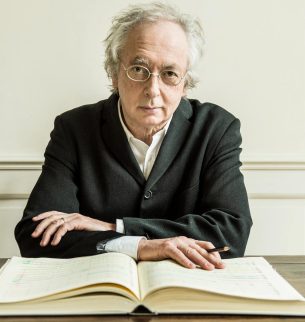
Philippe Herreweghe & Orchestre des Champs-Élysées

Bruckner's symphonies in their original sound
Higher
Symphony No. 8 in C minor is "one of the most astonishing creations not only of Bruckner, but of symphonic world literature as a whole; it has rightly been called 'the crown of 19th century music'." This judgment applies to the "1890 version" which premiered in 1892 altough it took until 1973 before the "1887 version" was performed for the first time. Anton Bruckner had begun this version in the summer of 1884 and, after its completion on 10 August 1887, he sent it to the conductor, Hermann Levi. The latter was baffled by the sheer size of the score and advised reworking it. The badly hurt composer finally did this as he realised that the size of the symphony exceeded any contemporary powers of imagination. In it, the first movement is followed by the Scherzo, moving the slow movement, in which the harp is used, uniquely for Bruckner, to the third position, while the themes of all four movements are bundled together and sound simultaneously in vertical layering at the end of the monumental finale.
The 'Eighth' is preceded by Heinrich Ignaz Franz Biber's famous Battalia, a lavishly scored musical battle painting, which, in terms of its exaggeration, is certainly related to the symphony and, thematically, also builds a bridge to Bruckner's own programme-musical interpretation of its finale, in which he claimed to have set the "Ride of the Cossacks", "military music" and "fanfares" to music.
These two masterpieces, which represent the Mount Everest of their respective genres, will be performed by Ars Antiqua Austria, Gunar Letzbor's ensemble for new baroque music, and the Champs-Élysées Orchestra, directed by its founder and director, Philippe Herreweghe. Two absolute top formations on the field of historical performance practice.
Heinrich Ignaz Franz Biber (1644-1704)
Battalia. Suite in D major, C 61 (1673)
Anton Bruckner (1824-1896)
Symphony No. 8 in C minor, WAB 108 (1884-87) "1887 version".
Ars Antiqua Austria
Gunar Letzbor | Violin & Direction
Orchestre des Champs-Élysées
Philippe Herreweghe | Conductor
Do. 12.09.24
19:00; Eröffnung
Linz
Nordico
Eine Suche nach der Identität Anton Bruckners
It's me, Toni.
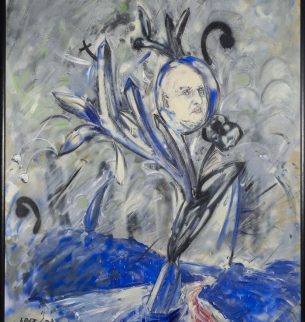
It's me, Toni.

Anton Bruckner is not just a local phenomenon in Upper Austria, but a world-renowned and recognized great as a musician. Who was this man, in whose honor an entire year is proclaimed in Linz and Upper Austria 200 years after his birth?
The exhibition embarks on a journey into Bruckner's past, exploring the set pieces that remain or have emerged over time and placing them in new contexts. Between provincial dust and the big city, we encounter an introverted nerd, an unrecognized genius and his search for love. The life and work of the musical genius is illuminated as well as critically questioned from today's perspective. Views, original artifacts and documents, and contemporary visualizations shed new light on a great musician. In six themed rooms, the story of Bruckner is retold and made tangible.
A project of the Nordico City Museum in cooperation with the Upper Austrian KulturEXPO Anton Bruckner 2024
Simon-Wiesenthal-Platz 1 4020 Linz Details & Tickets
Do. 12.09.24
19:30
Linz
Brucknerhaus Linz
Experimentieren Bruckners „Annullierte“ im Originalklang
Jordi Savall & Le Concert des Nations
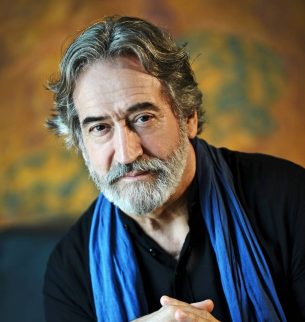
Jordi Savall & Le Concert des Nations

Bruckner's symphonies in the original sound
Experimentation
In January 1869, shortly after his appointment as Professor of Harmony and Counterpoint at the Conservatory of the Gesellschaft der Musikfreunde in Vienna, Anton Bruckner began work on a symphony in D minor, which he named "No 2" in his autograph. This explains why its outdated designation as the "Zeroth" is not only misleading, but simply wrong. Presumably due to critical reactions - the conductor ,Felix Otto Dessoff, is said to have asked about the beginning: "Yes, where is the theme?" - Bruckner withdrew the symphony, probably in 1873, only jotting down "annulirt" in the score in 1895, which gave it the nickname the "Annulierte ". Long since recognized as a fully-fledged Bruckner symphony, the focus is now increasingly on the work's decidedly experimental traits in particular.
Bruckner's " Annulled" is by no means the only symphony to be set aside by its composer. Franz Schubert did the same with his Symphony No. 7 in B minor, the famous "Unfinished". In 1822 he stopped working on this composition for reasons unknown at the beginning of the third movement. Robert Schumann did the same with his Symphony in G minor named "Zwickauer" after the place where the premiere of its first movement was performed. Only the first two movements were completed in 1832 and 1833.
Le Concert des Nations, unquestionably one of the best original sound orchestras in the world, whose members come mainly from Romance and Latin American countries, and its founder, Jordi Savall, who last performed at the Brucknerhaus Linz more than a quarter of a century ago, take on the three symphonic children 'rejected' by their composer fathers.
Franz Schubert (1797-1828)
Symphony No. 7 ("Unfinished") in B minor, D 759 (1822)
Robert Schumann (1810-1856)
Symphony ("Zwickau") in G minor, WoO 29 (1832-33)
- Intermission -
Anton Bruckner (1824-1896)
Symphony ("Annulled") in D minor, WAB 100 (1869)
Le Concert des Nations
Jordi Savall | Conductor
Sa. 14.09.24
19:30
Linz
Brucknerhaus Linz
Fortfahren - Bruckners Sinfonien im Originalklang
Martin Haselböck & Orchester Wiener Akademie
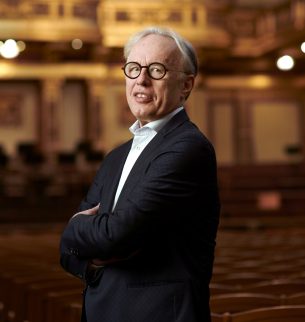
Martin Haselböck & Orchester Wiener Akademie

Bruckner's symphonies in their original sound
Continue
Anton Bruckner introduced himself as a symphonist in Vienna with his Symphony No. 2 in C minor, which was largely completed in St. Florian in September 1872. However, its premiere by the Vienna Philharmonic Orchestra on 26 October 1873, conducted by Bruckner himself, was only a respectable success. The reaction from the press mirrored the ambivalent attitude between fascination and irritation that was to become characteristic of the contemporary reception of work from Bruckner. The numerous general pauses, which were used as a structuring element and became the undoing of the work, which in itself is "of great lyrical beauty, delicacy and transparency of structure" , in the form of the unflattering nickname "Pausen-Sinfonie" . After the Vienna Philharmonic left his request unanswered in 1873, Bruckner planned to dedicate the 'Second' to "the master Franz Liszt in the most heartfelt reverence" in 1884, but refrained from doing so after Liszt carelessly left behind the dedication copy of the score he had given him on his departure from Vienna.
The 'Second' is appropriately accompanied by two second works by Liszt: the orchestral version of the popular Hungarian Rhapsody No. 2 in D minor and the Piano Concerto No. 2 in A major, whose eventful composition and arrangement history, spanning more than 30 years, rivals that of any Bruckner symphony.
The interpretation of the three works, whose ordinal number 2 signals a continuation and advancement in the three genres, is in the hands of Martin Haselböck and the Orchester Wiener Akademie, who have recorded all of Liszt's orchestral works in their original sound and have not only done pioneering work in this respect, but have also added the star pianist, Kit Armstrong, as a soloist in the piano concerto. He is adept at playing both historical and modern grand pianos.
Franz Liszt (1811-1886)
Hungarian Rhapsody No. 2 in D minor, p. 359, No. 2 (1847, 1857-60)
Concerto for Piano and Orchestra No. 2 in A major, p. 125 (1830-39, rev. 1849, 1853, 1857, 1861)
- Intermission -
Anton Bruckner (1824-1896)
Symphony No. 2 in C minor, WAB 102 (1871-72, rev. 1873, 1876) "1872 version"
Kit Armstrong | Piano
Vienna Academy Orchestra
Martin Haselböck | Conductor
So. 15.09.24
14 Uhr
Linz
Brucknerhaus Linz
Die Sinfonie des Laufens
Oberbank Anton Bruckner Lauf Linz

Oberbank Anton Bruckner Lauf Linz

Sport and culture - constantly linked: Nowhere does this work as well as in Linz, where the Danube lifeline has always set the pace and where Anton Bruckner, Upper Austria's great world-class composer, is also leading the way in many ways on his 200th birthday. Premiere for the Oberbank Anton Bruckner Lauf Linz on September 15, 2024 - register now!
Where, if not in Upper Austria, where "sporting" through the diverse natural landscapes has developed into a real mass movement in recent decades, and in the middle of the marathon "stronghold" and provincial capital Linz, where the Oberbank Linz Donau Marathon attracts up to 20,000 ambitious amateur runners from 80 nations to the spectacular start in the middle of the Voest highway bridge once a year, a new symphony will be created in 2024. One of running, dedicated to Anton Bruckner and his work. The Anton Bruckner running course with start and finish at the Brucknerhaus Linz.
A symphony of running
It is not known that Bruckner was particularly fond of athletics in addition to his groundbreaking musical work and his attachment to tradition in the Land ob der Enns. On the 200th birthday of Upper Austria's great son, the Anton Bruckner running track is more of an offer to the current generation. At the same time, however, it also invites you to rediscover the work of the famous composer: Based on the number of Bruckner symphonies, the distance is nine kilometers and acoustic signposts allow the master's musical work to be heard.
The Oberbank Anton Bruckner Lauf Linz will celebrate its grand opening on September 15, 2024. As a fun run for all sports enthusiasts, held according to the rules of the Austrian Athletics Association, the course first runs to the Lentos Art Museum, turns there and continues along the Danube banks to the narrow headland at Winterhafen to the turning point at Spitz (kilometer 3). After crossing the Voest freeway bridge (kilometer 5) to the northern bank of the Danube, the course continues to the Ars Electronica Center (kilometer 7) and back over the New Railway Bridge.
In the "pace zones" at the start of each of the nine kilometers, participants are greeted by one of Anton Bruckner's impressive symphonies. In addition, ground markings in the design of the anniversary year "Anton Bruckner 2024" show the way to the finish line at kilometer 9.3 at the Brucknerhaus Linz. Once there, all finishers will receive a special medal and a full refreshment bar. The winners will also receive honorary prizes. Women and men will be judged in age groups.
Oberbank Anton Bruckner Run Linz
Competitions: Running and Nordic Walking
Start and finish: Brucknerhaus Linz
Race number pick-up: 9 am to 1 pm, Brucknerhaus Linz
Start: 2 p.m.
Winners' ceremony: 4 p.m., Brucknerhaus Linz
Changing rooms and showers: Fitnessoase Parkbad Linz (free of charge)
Entry fee: € 24,-
Entry deadline: September 1, 2024
Attention: Limited number of participants, please register quickly!
Concept, production: LIVA Sport & Linz Donau Marathon
So. 15.09.24
18:00
Linz
Brucknerhaus Linz
Internationales Brucknerfest Linz 2024
Klassische Klangwolke 24

Klassische Klangwolke 24

presented by SPARKASSE OÖ & LINZ AG
Song recital
Like the New Year's Concert, the program of the first of two recitals at the International Bruckner Festival Linz 202 4 draws attention to the fact that 2024 is by no means just a Bruckner year.
A concert not only for the 200th birthday of Anton Bruckner, who loved lieder but only left behind a dozen or so contributions to the genre, but also for the 120th anniversary of the death of Antonín Dvořák, who was the first Czech composer to write a significant number of lieder, for the 160th anniversary of the birth and 75th anniversary of the death of Richard Strauss, of whose 170 or so piano songs an astonishingly large number have found their way into the standard repertoire, for the 150th birthday of Arnold Schoenberg, for whom lieder composition served as an experimental laboratory on his way to overcoming tonality. The 150th birthday of Arnold Schönberg, for whom song composition served as an experimental laboratory on his way to overcoming tonality, as formal coherence could be constituted through the text, and the 150th birthday and 70th anniversary of the death of Charles Ives, whose more than "150 songs represent perhaps the most significant contribution of American music to musical modernism ever" and whose work as a whole has significantly changed, but above all expanded, the popular conception of music, challenging performers and listeners alike to this day.
The well-wishers, two grand masters of their craft, are star baritone Thomas Hampson and his long-time piano accompanist Wolfram Rieger. The two have performed hundreds of recitals together, but never before have they appeared as a duo at the Brucknerhaus Linz. Now the local audience will finally have the pleasure of hearing these exceptional artists perform what Thomas Hampson recently stated in an interview: "Song is a testimony and diary of human existence".
Songs from
Anton Bruckner (1824-1896)
Antonín Dvořák (1841-1904)
Richard Strauss (1864-1949)
Arnold Schönberg (1874-1951)
Charles Ives (1874-1954)
Thomas Hampson | Baritone
Wolfram Rieger | Piano
Further dates in the series
Di. 17.09.24
19:00
Linz
Club der Begegnung (CDB)
Further dates
2. Präsentation der Symposium-Ergebnisse
Bruckner drucken
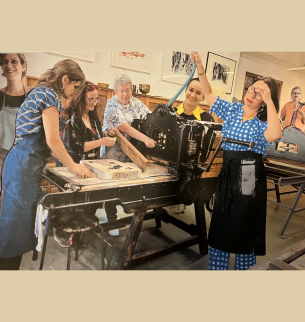
Bruckner drucken

7 artists print lithographs from stone thus creating their own personal reference to Anton Bruckner.
In contrast to earlier times - in the 18th century in the days of the inventor Senefelder, where there were only male artists and printers - or even in Anton Bruckner's lifetime, printed matter was printed by men. Only later, as the only exception among artists, did Käthe Kollwitz become an artistic role model with a strong statement in her lithographs.
Today, female artists are even in the majority, even in physically difficult, elaborate, old printing techniques, such as lithography according to Senefelder.
This beautiful, special technique has not become obsolete without the digital simplification of the press.
During the symposiumyou can look over the artists' shoulders every day from 15 - 21 August 2024.
1st presentation of the symposium results:
31.08.2024 at 16:00 hrs.
in Laakirchen in the papermaking museum (lower level)
2nd presentation Bruckner in print:
17.09.2024 at 19:00
A project by Renate Moran in cooperation with the Upper Austrian KulturEXPO Anton Bruckner 2024.
Renate Moran
Monika Breitenfellner
Mariam Chikava
Olga Djomina
Inga Hehn
Helene Huemer
Georgina Lovelady Krausz
Country road 31 4020 Linz
Di. 17.09.24
19:30
Linz
Brucknerhaus Linz
Entgrenzen - Bruckners 6. Sinfonie im Originalklang
Marc Minkowski & Les Musiciens du Louvre
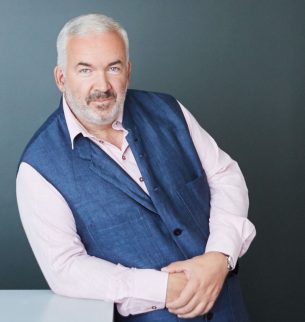
Marc Minkowski & Les Musiciens du Louvre

Bruckner's symphonies in their original sound
Delimitation
After completing the String Quintet in F major, Anton Bruckner began work on his Symphony No. 6 in A major in August 1879. He completed this on 3 September 1881, one day before his 57th birthday, in St. Florian, to where he had travelled at the beginning of August. It was from here also that he left for Linz to visit "the folk festival associated with an exhibition" . Although he was able to hear the symphony on 6 October 1882 at a rehearsal of the Vienna Philharmonic, at which the musicians, as he reported in a letter to his friend, Leopold Hofmeyr ,from Steyr, "applauded him vigorously and banged the cymbols together loudly", only the middle movements were premiered in Vienna on 11 February 1883, which is why Bruckner did not revise the work. The fact that the entire symphony was not performed in public until after his death is all the more astonishing given that, despite its variety of forms, it is a true "miracle of control and concentration" .
The three-movement Symphony in D minor was composed between 1886 and 1888 by César Franck. He was only two years older than Bruckner and a famous organist. In France he was regarded as the successor to Ludwig van Beethoven. He made the phrase from the String Quartet No. 16 in F major from Ludwig von Beethoven, which was underlaid with the question "Must it be?" , the motivic nucleus of his masterpiece.
With this fascinating programme, the renowned original sound ensemble, Les Musiciens du Louvre, which is now in its 43rd year of existence, turns for the first time to one of Bruckner's symphonies, with which its founder and director, Marc Minkowski, has been intensively involved for some time as a sought-after and celebrated guest conductor of orchestras playing on modern instruments.
César Franck (1822-1890)
Symphony in D minor, FWV 48 (1886-88)
- Intermission -
Anton Bruckner (1824-1896)
Symphony No. 6 in A major, WAB 106 (1879-81)
Les Musiciens du Louvre
Marc Minkowski | Conductor
Do. 19.09.24
19:30
Linz
Brucknerhaus Linz
Bruckners ‚Erste‘
Christian Thielemann & Wiener Philharmoniker
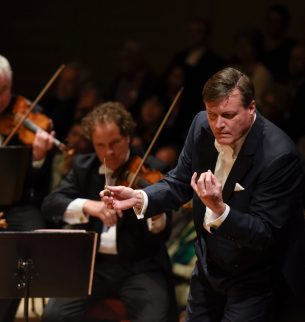
Christian Thielemann & Wiener Philharmoniker

Bruckner's 'First
His own, highly individual symphonic style was first documented by Bruckner's Symphony No. 1 in C minor, premiered in Linz on May 9, 1868, with which the composer, already over 40 years old, set off into new worlds and confidently entered the musical field that he declared to be the most important for him: that of symphonic music. When he subjected the work to a fundamental revision from 1890 onwards, resulting in its "Viennese version", which the Vienna Philharmonic Orchestra premiered on December 13, 1891 under the direction of Hans Richter, he affectionately and jokingly called it "das kecke Beserl" (the cheeky little fellow)
Although the Vienna Philharmonic was already closely associated with the composer during his lifetime thanks to these and other world premieres and is still one of the most important "Bruckner orchestras" in the world today, they have only recently released their first complete recording of all eleven symphonies under a single conductor: Christian Thielemann, who will also be conducting their concert at the International Bruckner Festival Linz 202 4.
Felix Mendelssohn Bartholdy (1809-1847)
The Hebrides. Concert Overture No. 2 in B minor, op. 26 (1829-30, rev. 1832 & 1835)
Symphony No. 3 ("Scottish") in A minor, op. 56 (1829-42)
- Intermission -
Anton Bruckner (1824-1896)
Symphony No. 1 in C minor, WAB 101 (1865-66, rev. 1877, 1889-91) "Viennese version"
Vienna Philharmonic Orchestra
Christian Thielemann | Conductor
Fr. 20.09.24
19:30
Linz
Pfarrkirche St. Severin
Wolfgang Dorninger - an_TON_Linz 2024
Bruckner Remixed In Space

Bruckner Remixed In Space

The performance "Bruckner Remixed In Space" will take place in several sound spaces in St. Severin. A total of 36 Tannoy loudspeakers will be set up in an acousmatic performance arrangement. During the performance, it is important to just listen to the space. Bruckner's works will be so heavily processed using audio software that the music will sound like a distant "200-year-old" echo.
No admission, a donation is requested. Reservations due to lack of space by email to dorninger@base.at
Wolfgang Dorninger
Wolfgang Dorninger | organizer, concept, music, remix, electronics
Geza Eisserer | Soundsystem - 36 Tannoy speakers in different designs
Fatima El Kosht | trumpet, flute
Wolfgang Kreuzhuber | Organ
Lederergasse 50 4020 Linz Details & Tickets
Fr. 20.09.24
19:30
Linz
Ignatiuskirche - Alter Dom
Internationales Brucknerfest Linz 2024
Michi Gaigg & L’Orfeo Barockorchester
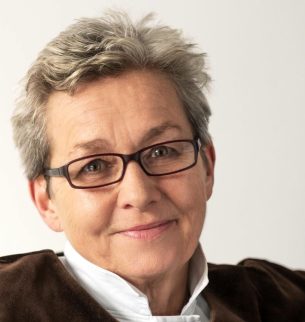
Michi Gaigg & L’Orfeo Barockorchester

Bruckner's Mass in D minor
The Old Cathedral in Linz played an important role in Anton Bruckner's life. It was here that he was appointed cathedral organist in 1855, a position he held for 13 years before moving to Vienna in 1868. However, it was also here that on 20 . It was also here that his Mass (No. 1) in D minor was premiered on November 20, 1864, which brought Bruckner great personal success. The reviewer of the Linzer Zeitung Franz Gamon proved to be particularly perceptive when he wrote: "Mr. Bruckner has not only solved the highest tasks of musical art with great mastery, but has also proven his talent for the higher style, the symphony."
In the Bruckner anniversary year 2024, Bruckner's Mass in D minor, the first of his works in which the personal signature of the later symphonist is clearly recognizable, will be heard again at the place of its premiere. But that's not all: some of the participants in this concert also have close links to Bruckner's biography. The Hard Choir, for example, emerged from the Linz Liedertafel "Frohsinn", which Anton Bruckner led as choirmaster from 1860 to 1861 and again in 1868 and with which he premiered the final chorus from Richard Wagner's opera Die Meistersinger von Nürnberg . The male choir of former St. Florian Boys' Choir reminds us that Bruckner's own musical career began as a choirboy at this monastery, whose organist he later became and under whose organ he is buried. With the L'Orfeo Barockorchester under its founder Michi Gaigg, a top ensemble from Upper Austria and an important Upper Austrian conductor are also at work to pay tribute to their great compatriot on his 200th birthday.
Anton Bruckner (1824-1896)
Psalm 112 in B flat major for two four-part mixed choirs and orchestra, WAB 35 (1863)
Ave Maria. Offertorium in F major for seven-part mixed choir a cappella, WAB 6 (1861)
"Ecce sacerdos magnus". Responsorium in A minor for four-part mixed choir, three trombones and organ, WAB 13 (1885)
Mass (No. 1) in D minor for soloists, four-part mixed choir, orchestra and organ, WAB 26 (1864, rev. 1876, 1881-82)*.
as well as works by
Johann Baptist Schiedermayr (1779-1840)
Karl Borromäus Waldeck (1841-1905)
Hard-Chor Linz
Alexander Koller | Management
* Men's choir of the
St. Florian Boys Choir
L'Orfeo Baroque Orchestra
Bernhard Prammer | Organ
Michi Gaigg | Conductor
Sa. 21.09.24
19:30
Linz
Brucknerhaus Linz
Beginnen - Bruckners 1. Sinfonie im Originalklang
Christoph Spering & Das Neue Orchester
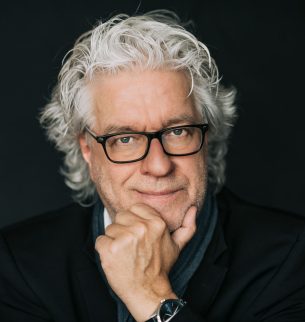
Christoph Spering & Das Neue Orchester

Bruckner's symphonies in their original sound
Begin
The juxtaposition of the first works of two 'late symphonists' - Anton Bruckner and Johannes Brahms were already 43 years old at the premiere of their 'First' - makes it clear that the symphonies of these supposed antipodes have a common root: Ludwig van Beethoven, whose Coriolan Overture in C minor is not coincidentally followed by the symphonies in the concerto, each in the same key, attacca.
Although Brahms still complained in the early 1870s that he would probably "never compose a symphony" as he "always heard such a giant (Beethoven) marching behind him" , he repeatedly occupied himself with a "1st Symphony Movement" sketched in 1862 , on the basis of which he finally completed his Symphony No. 1 in C minor in 1876, a full 14 years later. The influence of the "giant" on the work was so striking that the conductor Hans von Bülow's bon mot soon made the rounds that it was Beethoven's "tenth symphony".
Looking back, Bruckner called his Symphony No. 1 in C minor, completed in 1866 and premiered in Linz in 1868, "Das kecke Beserl" . And indeed, what an impetuous work, what a revolutionary work! In 1865, Bruckner had learned his craft, internalized the compositional tradition and made the acquaintance of Richard Wagner's music. Equipped with these tools, he set off into new worlds with his first numbered symphony and confidently entered the musical field that he declared to be the most important for him: that of symphonic music.
Under the direction of Christoph Spering, Das Neue Orchester presents two symphonic experiments that should prove to be milestones in the development of the genre and thus worthy of the great role model of their creators.
Ludwig van Beethoven (1770-1827)
Overture in C minor to Heinrich Joseph von Collin's tragedy Coriolan, op. 62 (1807)
Johannes Brahms (1833-1897)
Symphony No. 1 in C minor, op. 68 (1862-76, rev. 1877)
- Intermission -
Ludwig van Beethoven
Overture in C minor to Heinrich Joseph von Collin's tragedy Coriolan, op. 62 (1807)
Anton Bruckner (1824-1896)
Symphony No. 1 in C minor, WAB 101 (1865-66) "Linz Version
The New Orchestra
Christoph Spering | Conductor
Di. 24.09.24
19:30
Linz
Ignatiuskirche - Alter Dom
Internationales Brucknerfest Linz 2024
Tenebrae Choir
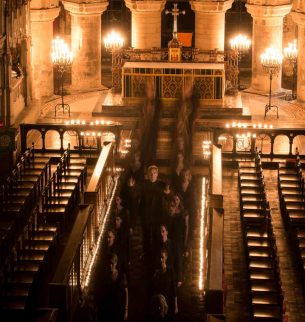
Tenebrae Choir

Two choir concerts in the Old Cathedral
Anton Bruckner expressly saw himself "as a symphonist" and strove for recognition as such, but until the mid-1880s, when the success of Symphony No. 7 in E major finally led to increased interest in his symphonic works, he was primarily perceived by the public as a famous organ improviser and composer of successful sacred music. This includes not only his great masses or the Te Deum, but also a large number of individual liturgical works written over a period of around 50 years for a wide variety of occasions and instrumentations.
The Tenebrae Choir, which was founded in 2001 by Nigel Short and is still directed by him today and has long been one of the world's leading vocal ensembles, is taking on this repertoire with two pure yet extraordinarily varied Bruckner programs, presenting the entire sacred a cappella and organ (or piano) and/or trombone-accompanied choral works of the composer on two consecutive evenings in the Old Cathedral, to which a few songs for voice and organ are added. In addition to popular motets such as Ave Maria, "Christus factus est" and "Locus iste ", there are also some unknown pieces that are worth getting to know, and one or two rarities to discover, such as the two pieces by Franz Joseph Aumann - who was Regens Chori at St. Florian's Abbey from 1755 until his death in 1797. Florian Abbey from 1755 until his death in 1797 - "Ecce quomodo moritur justus" and "Tenebrae", to each of which Bruckner added a three-part trombone movement in 1878.
Anton Bruckner (1824-1896)
"Pange lingua". Hymn in C major for four-part mixed choir a cappella, WAB 31, No. 1 (1835-37)
"Tantum ergo". Hymn in B flat major for four-part mixed choir and organ, WAB 41, No. 1 (1846)
"Ave Maria. Offertorium in F major for seven-part mixed choir a cappella, WAB 6 (1861)
"Ave Regina coelorum". Marian antiphon for unison voices and organ, WAB 8 (around 1886)
"Asperges" in F major for four-part mixed choir a cappella, WAB 4 (1843-44)
Mass in F major without Kyrie and Gloria (for Maundy Thursday = "Christus factus est" [I]) for four-part mixed choir a cappella, WAB 9 (1844)
Herz Jesu-Lied in B flat major for soprano, tenor and bass solo, four-part mixed choir and organ, WAB 144 (c. 1845/46?)
Totenlied (I) in E flat major for four-part mixed choir a cappella, WAB 47, No. 1 (1852)
Am Grabe in F minor for four-part male choir a cappella, WAB 2 (1861)
"Ecce quomodo moritur justus". Responsorium in G minor for four-part mixed choir a cappella by Franz Joseph Aumann (1728-1797) with trombone part by Anton Bruckner, WAB add 265 (1878)
"Os justi". Gradual in Lydian for four to eight-part mixed choir a cappella, WAB 30, No. 2 (1879)
"Inveni David" (II) Lydian for unison voices and organ, WAB 20 (1879)
22nd Psalm in E flat major for soloists, four-part mixed choir and piano, WAB 34 (c. 1852)
- Intermission -
Anton Bruckner
"Tantum ergo". Hymn in D major for four-part mixed choir a cappella, WAB 32 (1843)
"To you, Lord, to you I will surrender". Chorale in A major for four-part mixed choir a cappella, WAB 12 (around 1844/45)
"Tantum ergo". Hymn in D major for five-part mixed choir and organ, WAB 42, No. 1 (1846)
"Ave Maria" in F major for alto voice and organ, WAB 7 (1882)
"Tantum ergo". Hymn in A flat major for four-part mixed choir and organ, WAB 41, No. 2 (1846)
"O you dear child of Jesus". Song in F major for voice and organ, WAB 145 (1845/46)
Mass without Gloria [and Credo] ("Kronstorf Mass") in D minor for four-part mixed choir a cappella, WAB 146 (1844)
Renunciation. Cantata in B flat major for soprano or tenor solo, four-part mixed choir and organ (or piano), WAB 14 (around 1851)
"Tantum ergo". Hymn in A major for four-part mixed choir and organ, WAB 43 (1844 or 1845)
Obituary in C minor for four-part male choir and organ, WAB 81a (1877)
"In that last of the nights". Choral in F minor for voice and organ, WAB 17, No. 1 (1848)
"In that last of the nights". Choral in F minor for four-part mixed choir a cappella, WAB 17, No. 2 (1848)
"Tantum ergo". Hymn in B flat major for four-part mixed choir a cappella, WAB 41, No. 1 (1846, rev. 1888)
"Libera me". Responsorium in F minor for five-part mixed choir, three trombones and basso continuo (violoncello and organ), WAB 22 (1854)
Tenebrae Choir
James Sherlock | Organ
Nigel Short | Management
Mi. 25.09.24
19:30
Linz
Ignatiuskirche - Alter Dom
Internationales Brucknerfest Linz 2024
Tenebrae Choir

Tenebrae Choir

Two choir concerts in the Old Cathedral
Anton Bruckner expressly saw himself "as a symphonist" and strove for recognition as such, but until the mid-1880s, when the success of Symphony No. 7 in E major finally led to increased interest in his symphonic works, he was primarily perceived by the public as a famous organ improviser and composer of successful sacred music. This includes not only his great masses or the Te Deum, but also a large number of individual liturgical works written over a period of around 50 years for a wide variety of occasions and instrumentations.
The Tenebrae Choir, which was founded in 2001 by Nigel Short and is still directed by him today and has long been one of the world's leading vocal ensembles, is taking on this repertoire with two pure yet extraordinarily varied Bruckner programs, presenting the entire sacred a cappella and organ (or piano) and/or trombone-accompanied choral works of the composer on two consecutive evenings in the Old Cathedral, to which a few songs for voice and organ are added. In addition to popular motets such as Ave Maria, "Christus factus est" and "Locus iste ", there are also some unknown pieces that are worth getting to know, and one or two rarities to discover, such as the two pieces by Franz Joseph Aumann - who was Regens Chori at St. Florian's Abbey from 1755 until his death in 1797. Florian Abbey from 1755 until his death in 1797 - "Ecce quomodo moritur justus" and "Tenebrae", to each of which Bruckner added a three-part trombone movement in 1878.
Anton Bruckner (1824-1896)
"Pange lingua". Hymn in C major for four-part mixed choir a cappella, WAB 31, No. 2 (1891)
In Sanctum Angelum custodem. Hymn in G minor for four-part male choir a cappella, WAB 18, No. 2 (1886)
"Tantum ergo". Hymn in A flat major for four-part mixed choir a cappella, WAB 41, No. 2 (1846, rev. 1888)
"Virga Jesse floruit". Graduale in E minor for four-part mixed choir a cappella, WAB 52 (1885)
"Salvum fac populum tuum" in F major for four-part mixed choir a cappella, WAB 40 (1884)
"Veni creator spiritus". Hymn in F major for voice(s) and organ, WAB 50 (around 1884)
"Tantum ergo". Hymn in E flat major for four-part mixed choir a cappella, WAB 41, No. 3 (1846, rev. 1888)
"Ave Maria" in F major for soprano and alto solo, four-part mixed choir, violoncello and organ, WAB 5 (1856)
Two "Asperges" in Aeolian and F major for four-part mixed choir and organ, WAB 3, nos. 1 & 2 (1843-45)
Wedding chorus in F major for solo quartet, four-part male choir and organ, WAB 49 (1865)
Vor Arneths Grab in F minor for four-part male choir and three trombones, WAB 53 (1854)
"Afferentur regi virgines post eam". Offertorium in F major for four-part mixed choir and three trombones, WAB 1 (1861)
"Tantum ergo". Hymn in E flat major for four-part mixed choir and organ, WAB 41, No. 3 (1846)
"Tenebrae". Responsory in G minor for four-part mixed choir a cappella by Franz Joseph Aumann (1728-1797) with trombone part by Anton Bruckner, WAB add 268 (1878)
Totenlied (II) in F major for four-part mixed choir a cappella, WAB 47, No. 2 (1852)
114th Psalm in G major for five-part mixed choir and three trombones, WAB 36 (1852)
- Intermission -
Anton Bruckner
"Pange lingua" et "Tantum ergo". Hymn Phrygian for four-part mixed choir a cappella, WAB 33 (1868)
"Tantum ergo". Hymn in C major for four-part mixed choir and organ, WAB 41, No. 4 (1846)
"Vexilla regis". Phrygian hymn for four-part mixed choir a cappella, WAB 51 (1892)
"Tota pulchra es, Maria". Antiphon Phrygian for tenor solo, four-part mixed choir and organ, WAB 46 (1878)
"Libera me". Responsory in F major for four-part mixed choir and organ, WAB 21 (1843-45)
"Christus factus est" (III). Gradual in D minor for four-part mixed choir a cappella, WAB 11 (1884)
In Sanctum Angelum custodem. Hymn in Phrygian for four-part mixed choir a cappella, WAB 18, No. 1a (1868)
In Sanctum Angelum custodem. Hymn in E minor for four-part mixed choir and organ, WAB 18, No. 1b (1868)
"Locus iste". Gradual in C major for four-part mixed choir a cappella, WAB 23 (1869)
"Inveni David" (I). Offertorium in F minor for four-part male choir and four trombones, WAB 19 (1868)
"You are like a flower" in F major for mixed vocal quartet a cappella, WAB 64 (1861)
"Ecce sacerdos magnus". Responsorium in A minor for four-part mixed choir, three trombones and organ, WAB 13 (1885)
Tenebrae Choir
James Sherlock | Organ
Nigel Short | Management
Do. 26.09.24
12:30
Linz
Brucknerhaus Linz
Internationales Brucknerfest Linz 2024
Hans Rott – Bruckners Lieblingsschüler
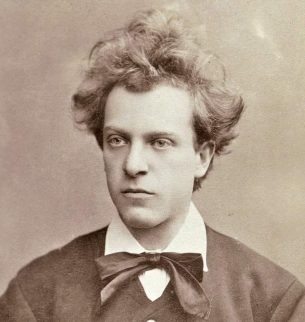
Hans Rott – Bruckners Lieblingsschüler

Tasting rehearsal excerpts from Rott's Symphony No. 1
Hans Rott, born in 1858, studied organ with Anton Bruckner at the Conservatory of the Gesellschaft der Musikfreunde in Vienna from 1874 and, together with Gustav Mahler, composition with Franz Krenn. At the final composition examination in 1878, he presented the first movement of his Symphony (No. 1) in E major, completed in 1880, and was the only student of the year not to receive a prize, whereupon Bruckner is said to have shouted to the amused examination board: "Don't laugh, gentlemen, you'll hear great things from this man!" Bruckner already emphasized Rott's talent in a letter to Ignaz Traumihler on 14 June 1877: "He [...] is a brilliant musician [...] and [...] has been my best pupil so far." Heinrich Krzyzanowski, a close friend of Rott, later wrote about the intimate relationship between teacher and pupil: "None of the younger ones was as close to him [Bruckner] as R[ott]. Both were deeply religious, not to say Catholic. Both belonged to the organ & the organ to them."
Plagued by financial worries and after his symphony was rejected by the jury for the Beethoven Scholarship of the Gesellschaft der Musikfreunde in Vienna, of which Johannes Brahms was also a member, Rott's mental illness, which had already begun to show, broke out at the end of October 1880 on the train journey to Mulhouse in Alsace, where he was planning to take up a position as choirmaster. Rott tried to stop a passenger from lighting a cigar at gunpoint, fearing that Brahms had had the carriage filled with dynamite. In 1884, after several suicide attempts, Rott died of tuberculosis in a psychiatric institution at the age of just 25.
Excerpts from:
Hans Rott (1858-1884)
Symphony (No. 1) in E major (1878-80)
Bruckner Orchestra Linz
Markus Poschner | Conductor
Do. 26.09.24
19:30
Linz
Brucknerhaus Linz
Aneignen – Bruckners 3. Sinfonie im Originalklang
Pablo Heras-Casado & Anima Eterna Brugge
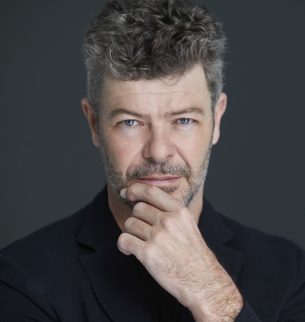
Pablo Heras-Casado & Anima Eterna Brugge

Bruckner's symphonies in their original sound
Acquire
Today, Anton Bruckner's symphonies are undisputedly among the summit works of the 19th century. Admittedly, we have become accustomed to hearing them performed on modern instruments whose sound does not correspond to the intentions of their creator. Bruckner wrote for string instruments with gut strings, which are both softer sounding and more blendable, and from 1868 explicitly for Viennese woodwind and brass instruments, whose colors were different from those we know from today's instruments. The result is a completely different overall sound, which allows Bruckner's music to appear in a new light. For the first time in the world, all eleven of Bruckner's symphonies will be performed in their original sound as part of the International Bruckner Festival Linz 2024, a journey of discovery in eleven concerts that can only be heard as a cycle at the Brucknerhaus Linz and there exclusively in Austria. The symphonies are always performed in their first version and thus in the form that Bruckner originally intended to give to each work, still unimpressed by the reactions of his fellow musicians. They are combined with compositions that owe their genesis to a similar impulse or were of exemplary importance to Bruckner, and they are performed by eleven of Europe's most renowned original sound orchestras under the direction of renowned conductors. A unique listening experience that only the Bruckner city of Linz has to offer in the Bruckner Year 2024.
Richard Wagner (1813-1883)
A Faust Overture in D minor, WWV 59 (1839-40, rev. 1843-44 & 1855)
Five poems for female voice and orchestra ("Wesendonck-Lieder"), WWV 91 (1857-58, 1893)
[Orchestration by Felix Mottl (1856-1911)]
- Intermission -
Anton Bruckner (1824-1896)
Symphony No. 3 in D minor, WAB 103 (1872-73) "1873 version".
Christiane Karg | mezzo-soprano
Anima Eterna Brugge
Pablo Heras-Casado | Conductor
Fr. 27.09.24
19:30
Linz
Brucknerhaus Linz
Internationales Brucknerfest Linz 2024
Markus Poschner & Bruckner Orchester Linz
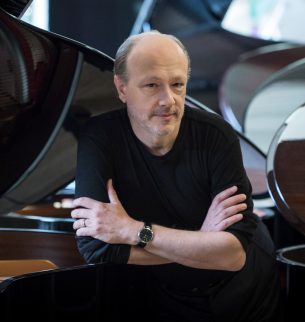
Markus Poschner & Bruckner Orchester Linz

A train full of dynamite
The Piano Concerto No. 2 in B flat major by Johannes Brahms resembles a "symphony with obbligato piano", as the critic Eduard Hanslick noted, with a playing time of around 50 minutes and its four instead of the usual three movements, whereby the innovative fusion of symphonic and concerto form does not stand in the way of a highly virtuoso solo part. When the work, with the composer as soloist, received its acclaimed premiere on November 9, 1881, Hans Rott, who had been mistrusted by Brahms, was already nearing his end, as Joseph Seemüller, who visited him in the psychiatric ward on the same day, reported to a mutual friend: "Hans [...] is still preoccupied with thoughts and plans that are all based on an erroneous connection between his circumstances and his fate. His physical appearance is poor."
His ingenious Symphony (No. 1) in E major conveys an indelible impression of what might have been if Rott's exceptional talent had been fully developed, and makes it possible to understand why Gustav Mahler recognized in his fellow student the "founder of the new symphony" and thus his direct role model. Like Brahms' Second Piano Concerto, begun in May 1878, the symphony is an astonishing masterpiece in which melodic and harmonic inventiveness, brilliant yet nuanced instrumentation, an individual tonal language and a complex network of motivic and thematic references create an astonishingly cohesive musical unity.
The star pianist Marc-André Hamelin and the Bruckner Orchestra Linz under the direction of its chief conductor Markus Poschner create a sonorous panorama of a conflict-ridden period full of compositional and aesthetic trench warfare, in the course of which Bruckner found himself exposed to fierce hostility and proclaimed the antipode of Brahms, while his favorite pupil Rott was caught between the fronts of musical conflict and ultimately in the mills of the so-called music controversy
Johannes Brahms (1833-1897)
Concerto for Piano and Orchestra No. 2 in B flat major, op. 83 (1878, 1881)
- Intermission -
Hans Rott (1858-1884)
Symphony (No. 1) in E major (1878-80)
Marc-André Hamelin | Piano
Bruckner Orchestra Linz
Markus Poschner | Conductor
Sa. 28.09.24
10:00
Linz
Ars Electronica Center
Themenwochenende: Being Anton

Themenwochenende: Being Anton

In 2024, the whole of Upper Austria will celebrate 200 years of Anton Bruckner. Together with the Bruckner Orchestra Linz, the Ars Electronica Futurelab team has created two impressive Bruckner experience worlds for visitors to the Ars Electronica Center, which we want to make the focus of our program this weekend.
Ars Electronica Centre
Ars-Electronica-Strasse 1 4040 Linz Details & Tickets
Sa. 28.09.24
10:30
Linz
Brucknerhaus Linz
Internationales Brucknerfest Linz 2024
Musik mit allen Sinnen
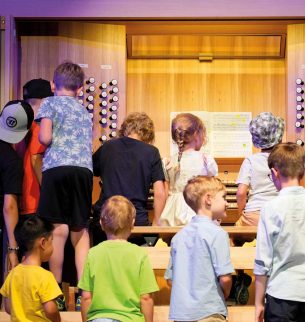
Musik mit allen Sinnen

An inclusive organ tour for everyone aged 0-99 with and without disabilities
The organ is the "queen of instruments". It allows us to experience music not just with our ears, but with our whole body: we feel the vibrations of the sound, touch the cold pipes and smell the wood. The versatile organist Martin Riccabona knows the organ at the Brucknerhaus Linz like no other. He accompanied the construction of the new instrument in 2018 and shares many interesting details about it. Perceive music with all your senses - that's what this interactive and inclusive tour full of hands-on elements offers. It is accompanied by an experienced music education team. And at the end, everyone can even play the organ themselves.
Duration: approx. 90 minutes
Martin Riccabona | Organ & Concept
Anna Dürrschmid, Petra Linecker, Malina Meier | Concept
Registration: possible from May 2024
The meeting point for the tour is the Service Center.
Sa. 28.09.24
18:15
Linz
Mariendom
155 Jahre - Weihe der Votivkapelle und Uraufführung der e-moll-Messe
Festgottesdienst
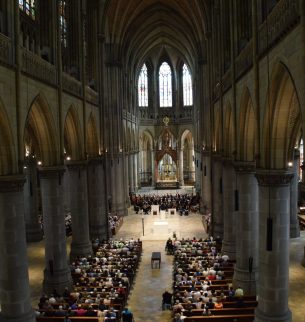
Festgottesdienst

155 years after its premiere, Bruckner's Mass in E minor will be performed in the Mariendom during a festive service.
Admission free
Diocese of Linz - Cathedral Music
Cathedral Choir Linz
Wind ensemble and choir of the Musikgymnasium Linz
Wolfgang Kreuzhuber | Cathedral organist
Andreas Peterl | Cathedral conductor
Cathedral Square 1 4020 Linz
Sa. 28.09.24
19:30
Linz
Brucknerhaus Linz
Studieren - Bruckners „Studiensinfonie“ im Originalklang
Stefan Gottfried & Concentus Musicus Wien
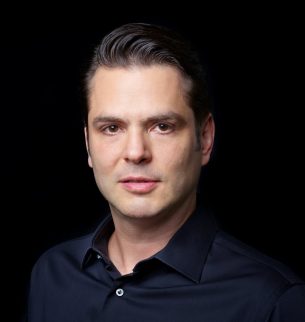
Stefan Gottfried & Concentus Musicus Wien

Bruckner's symphonies in their original sound
Study
Anton Bruckner turned to symphonic music late in life. He composed the Symphony in F minor, his first work, in 1863 at the age of 38 at the end of his two-year apprenticeship in Linz with Otto Kitzler, which earned it the nickname "Study Symphony" . Bruckner himself clearly regarded the work, which, despite all the influences of musical tradition that naturally found expression here, already had an individual style and an unconventional tone, as his "journeyman's piece" and initially made active efforts to have it performed.
Felix Mendelssohn Bartholdy's Sinfonia VIII in D major, which was clearly influenced by Wolfgang Amadé Mozart, was also composed in 1822 as part of his composition lessons with Carl Friedrich Zelter for practice purposes. As the only one of the twelve "string symphonies" , the 13-year-old added wind parts to it by 1823, transforming it into his first 'fully-fledged' symphony. In contrast, Ludwig van Beethoven began writing a piano concerto in 1786 at the age of 15 in order to introduce himself to the public as a pianist and composer. He spent 15 years revising the work, which was based on the models of Viennese Classicism. It was not published in print until 1801 as Piano Concerto No. 2 in B flat major, although it is actually the first.
The three "study works", with which their composers developed the respective genre, will be performed by the Concentus Musicus Wien, conducted by Stefan Gottfried and with keyboard virtuoso Kristian Bezuidenhout, a veritable original sound star, who performed works by Bruckner for the first time in its history at the International Brucknerfest Linz 2018 and has since been a regular guest at the Brucknerhaus Linz again after a break of well over a decade.
Felix Mendelssohn Bartholdy (1809-1847)
Sinfonia VIII ("String Symphony", in the version with winds) in D major, MWV N 8 (1822-23)
Ludwig van Beethoven (1770-1827)
Concerto for Piano and Orchestra No. 2 in B flat major, op. 19 (1786-92, rev. 1793, 1794-95, 1798, 1801)
- Intermission -
Anton Bruckner (1824-1896)
Symphony ("Study Symphony") in F minor, WAB 99 (1863)
Kristian Bezuidenhout | Piano
Concentus Musicus Vienna
Stefan Gottfried | Conductor
So. 29.09.24
11:00
Linz
Brucknerhaus Linz
Internationales Brucknerfest Linz 2024
NANU, NANI! 6+
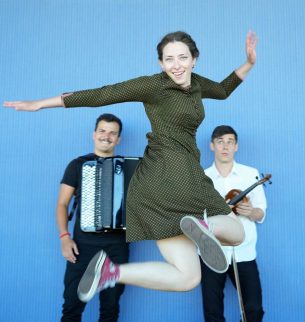
NANU, NANI! 6+

A musical suitcase theater about "Nani" Bruckner and her brother Anton for everyone aged 6 and over
Who is this young woman who bears a certain physical resemblance to the famous composer Anton Bruckner? Nanu, Nani! It is Maria Anna Bruckner, called "Nani" - Anton Bruckner's favorite sister and, not to forget, his domestic help in Linz and Vienna. In this interactive music theater, Anton Bruckner's life and work are told from a completely new perspective, namely that of his 'little' sister. The focus is on "Nani" herself, a person practically unknown today, who was an important and often probably even the only person Anton Bruckner cared for.
Nanu, Nani!
A musical suitcase theater about "Nani" Bruckner and her brother Anton (2024) [world premiere]
Sabine Rechberger | Maria Anna ("Nani") Bruckner
Tomáš Novák | Violin
Jakob Steinkellner | Accordion
Isabella Reder | Stage design & costumes
Anna Dürrschmid, Malina Meier | Concept
Di. 01.10.24
16:00
Linz
Ignatiuskirche - Alter Dom
ANTONS KIDSCLUB 6-10
Bruckners Orgel
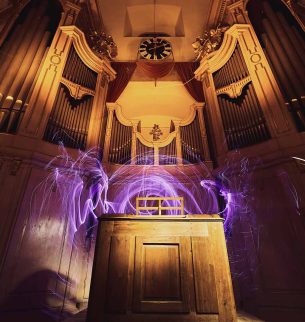
Bruckners Orgel

Bruckner's organ
The organist Bernhard Prammer will show us how the organ, on which Anton Bruckner worked for thirteen years during his time as organist of Linz Cathedral, sounds.
Meeting point is at 16:00 at the Old Cathedral, Linz
Your parents can simply take you to the Old Cathedral in Linz at 16:00 and pick you up again at 17:30, because of course only children have access to Anton's Kidsclub!
Di. 01.10.24
19:30
Linz
Brucknerhaus Linz
Internationales Brucknerfest Linz 2024
Quatuor Danel
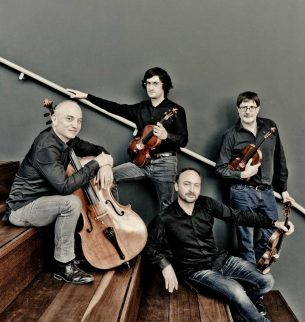
Quatuor Danel

Bruckner, his pupil Cyrill Hynais and their works for string quartet
Anton Bruckner's work for string quartet dates entirely from his time as a student of Otto Kitzler. It consists of the Six Scherzos, sketched in spring 1862 for practice purposes, as well as the Theme with Variations in E flat major, sketched soon afterwards, and culminates in the four-movement String Quartet in C minor, to which a "Rondo in larger form" was added as an alternative final movement shortly after completion in summer 1862. All of the pieces are preserved in the so-called Kitzler study book , which Bruckner compiled during his lessons with the Linz theater conductor between 1861 and 1863.
While these student works by Bruckner can hardly stand comparison with his symphonies, his teaching methods, which were aimed at profound compositional craftsmanship, bore astonishing fruit in the form of excellent chamber music works by his pupils. An outstanding example of this is the String Quartet in E major by Cyrill Hynais, 'rediscovered' a few years ago in the Austrian National Library and now edited and published for the first time, who attended Bruckner's counterpoint classes at the Conservatory of the Gesellschaft der Musikfreunde in Vienna from 1883 to 1885 and later became his close collaborator. The masterful work, completed in 1895, has recognizable characteristics of Bruckner's harmony and melody as well as echoes of Richard Wagner's musical language, but nowhere does it slide into the epigonal and in no way lacks an independent personal style.
The renowned, internationally acclaimed Quatuor Danel will present all of the great symphonist's contributions to the genre as well as the only string quartet by his pupil.
Anton Bruckner (1824-1896)
Six Scherzi for string quartet, WAB 209, Nos. 1-6 (1862)
Theme with Variations in E flat major for string quartet, WAB 210 (1862)
String Quartet in C minor, WAB 111 (1862)
Rondo in C minor for string quartet, WAB 208 (1862)
- Intermission -
Cyril Hynais (1862-1913)
String Quartet in E major (1895)
Quatuor Danel
Marc Danel | Violin
Gilles Millet | Violin
Vlad Bogdanas | Viola
Yovan Markovitch | Violoncello
Mi. 02.10.24
19:30
Linz
Brucknerhaus Linz
Internationales Brucknerfest Linz 2024
Julia Lezhneva & Helmut Deutsch

Julia Lezhneva & Helmut Deutsch

Song recital
The second song recital at the International Brucknerfest Linz 2024 is also dedicated to the jubilees of the year, but, apart from Anton Bruckner and Richard Strauss, it will focus on other composers from the Polish, Czech, German and French-speaking world, with a whole series of discoveries and surprises in store.
The program commemorates the 175th anniversary of the death of Frédéric Chopin, whose wonderful songs lead an undeserved shadowy existence next to his incomparably more famous piano works, celebrates the 200th birthdays of Bedřich Smetana, whose 140th anniversary of death is also being commemorated. It also celebrates the 150th anniversary of the death of Peter Cornelius, whose piano songs, often based on his own texts, impress with their successful synthesis of refinement and simplicity, and commemorates the 100th anniversary of the death of Gabriel Fauré. It commemorates the 100th anniversary of the death of Gabriel Fauré, whose song oeuvre is one of the most important written in this genre in France, and congratulates Reynaldo Hahn on his 150th birthday, whose song compositions, which have remained largely unknown in this country, bring the atmosphere of the Belle Époque to life in the most magical way.
The colorful bouquet of songs in honor of the seven composers is tied and presented by star soprano Julia Lezhneva, who is making her long overdue Brucknerhaus debut with this concert, and Helmut Deutsch, who has been one of the most sought-after and successful Lied pianists in the world for decades and yet has retained his curiosity as well as his interest in forgotten repertoire.
Songs from
Frédéric Chopin (1810-1849)
Bedřich Smetana (1824-1884)
Anton Bruckner (1824-1896)
Peter Cornelius (1824-1874)
Gabriel Fauré (1845-1924)
Richard Strauss (1864-1949)
Reynaldo Hahn (1874-1947)
Julia Lezhneva | Soprano
Helmut Deutsch | Piano
Do. 03.10.24
19:00; Eröffnung
Linz
Lentos Kunstmuseum
Vom Erheben der Stimme
ERÖFFNUNG: Komm sing mit!
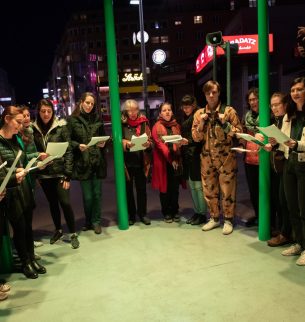
ERÖFFNUNG: Komm sing mit!

In its exhibition "Komm sing mit" the Lentos Museum of Art Linz focuses on the power of singing together as one, of raising one's voice". The show brings together national and international artists for whom singing is an important point of reference within their own artistic practice. In addition to videos and sound installations, participatory projects and a varied programme of support grant the opportunity to explore one's own voice.
Opening: 03.10.2024, 19:00
Exhibition duration: 04.10.24 - 05.01.25
Opening hours:
Tue, Wed, Fri, Sat, Sun: 10:00-18:00
Thu: 10:00-20:00
Lentos Art Museum
Ernst-Koref-Promenade 1 4020 Linz Details & Tickets
Do. 03.10.24
20:00
Linz
Mariendom
Internationales Brucknerfest Linz 2024
Ensemble Vocal de Lausanne & Daniel Reuss
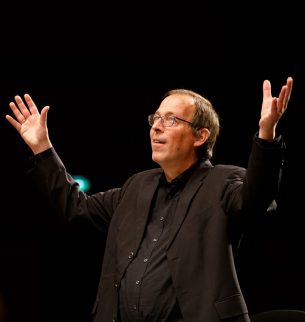
Ensemble Vocal de Lausanne & Daniel Reuss

Bruckner's Mass in E minor
The program of this church concert brings together all of Anton Bruckner's works that have a direct connection to St. Mary's Cathedral and thus also makes clear how closely the composer's name is linked to the history of the New Cathedral's construction.
It begins with the festive cantata in D major commissioned by Bishop Rudigier of Linz to mark the laying of the foundation stone of the Cathedral of the Immaculate Conception on May 1, 1862, and concludes with the Mass (No. 2) in E minor, which was commissioned by Rudigier for the inauguration of the Votive Chapel and composed in 1866, but only premiered on September 29, 1869 due to delays in the construction work. The performance of the mass in the concert is complemented by the 'interludes' originally intended for it, which were not sung at the time but can finally be heard in the context in which they belong: These are, after the Gloria, the popular "Locus iste" and, after the Credo, a "Pange lingua". In between, we hear the "Afferentur regi virgines post eam" dedicated to Johann Baptist Burgstaller, the choir director of the cathedral, the "Tota pulchra es, Maria" dedicated to Rudigier in 1878 for the 25th anniversary of his office and the "Virga Jesse floruit" composed in 1885 to celebrate the 100th anniversary of the diocese of Linz. Gerhard Raab, the second organist at St. Mary's Cathedral, also contributes two improvisations on Bruckner's themes on the Rudigier organ.
Conducted by Daniel Reuss, the renowned Ensemble Vocal de Lausanne celebrates its Brucknerhaus debut this evening and joins the long list of world-famous choirs that have performed in a concert organized by the Brucknerhaus Linz for the first time since the International Brucknerfest Linz 2018.
Anton Bruckner (1824-1896)
"Praise the Lord, praise his holy name". Festive cantata in D major for the laying of the foundation stone of the Mariä-Empfängnis-Dome in Linz for bass solo, male quartet, four-part male choir, winds and timpani, WAB 16 (1862)
Organ improvisation
"Afferentur regi virgines post eam". Offertorium in F major for four-part mixed choir and 3 trombones, WAB 1 (1861)
"Tota pulchra es, Maria". Antiphon Phrygian for tenor solo, four-part mixed choir and organ, WAB 46 (1878)
"Virga Jesse floruit". Graduale in E minor for four-part mixed choir a cappella, WAB 52 (1885)
Organ improvisation
Mass (No. 2) in E minor for eight-part mixed choir and winds, WAB 27 (1866, rev. 1876, 1882, 1885)
"Locus iste". Gradual in C major for four-part mixed choir a cappella, WAB 23 (1869)
"Pange lingua". Hymn Phrygian for four-part mixed choir a cappella, WAB 33 (1868)
Ensemble Vocal de Lausanne
* Lords of the Frohsinn choir house
Ensemble Instrumental de Lausanne
* Wind ensemble of the Anton Bruckner Private University
Gerhard Raab | Organ
Daniel Reuss | Conductor
Fr. 04.10.24
bis So. 05.01.25
Linz
Lentos Kunstmuseum
Vom Erheben der Stimme
Komm sing mit!

Komm sing mit!

In its exhibition "Komm sing mit" the Lentos Museum of Art Linz focuses on the power of singing together as one, of raising one's voice". The show brings together national and international artists for whom singing is an important point of reference within their own artistic practice. In addition to videos and sound installations, participatory projects and a varied programme of support grant the opportunity to explore one's own voice.
Exhibition duration: 04.10.24 - 05.01.25
Opening hours:
Tue, Wed, Fri, Sat, Sun: 10:00-18:00
Thu: 10:00-20:00
Lentos Art Museum
Ernst-Koref-Promenade 1 4020 Linz Details & Tickets
Fr. 04.10.24
10:30
Linz
Brucknerhaus Linz
Internationales Brucknerfest Linz 2024
Der Mensch Bruckner
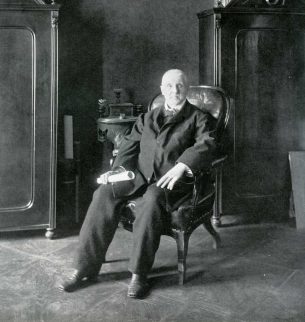
Der Mensch Bruckner

Scientific symposium in cooperation with the Anton Bruckner Institute Linz
On the occasion of the 200th anniversary of his birth, the academic symposium, which will of course once again be held in the anniversary year 2024 in the proven cooperation with the Anton Bruckner Institute, will focus on Anton Bruckner the man, who, on the one hand quite intentionally, and on the other hand not least due to the image of him that has been painted posthumously, seems to be literally hidden behind the artist's personality.
The presentations will focus on Bruckner's social existence, his private everyday life, his personal preferences, interests, habits and needs. In this context, questions such as how Bruckner actually lived apart from his artistic environment, what problems and banalities of daily life he was confronted with as a man of his time, what socio-cultural developments or changes in his era he took part in and what joys and sorrows moved him. In order to illuminate these multi-layered social and socio-historical aspects as comprehensively as possible, the internationally renowned speakers will approach the topic in an interdisciplinary discussion.
The aim of the two-day conference is to make the man Bruckner visible and tangible behind all those "stereotypes that have played and still play a dominant role in every study of Bruckner: good-natured and ingenious, wonderful and lost in the world, awkward and touching, the object not of enthusiasm but of amusement, in other words, in the famous words [...] from Hans von Bülow: 'half-genius + half-idiot'".
Friday from 10:30 am
Saturday from 9:00 am
Free admission
Fr. 04.10.24
19:30
Linz
Brucknerhaus Linz
Verklären – Bruckners 4. Sinfonie im Originalklang
Kent Nagano & Concerto Köln
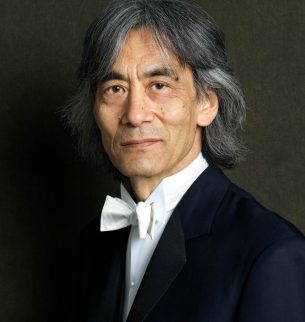
Kent Nagano & Concerto Köln

Bruckner's symphonies in their original sound
Transfigure
Although Symphony No. 4 in E flat major, which Anton Bruckner named the "Romantic", thus formally encouraging an illustrative understanding of the music, is one of Bruckner's most frequently performed works, this does not apply to its original version. The latter was composed in 1874 and revised in 1876. The enormous technical demands stood in the way of its dissemination from the very beginning. The last of all Bruckner symphonies, the "1874 version" of the 'Fourth' was not premiered until 20 September 1975, which took place in the Brucknerhaus Linz.
The symphony is preceded by two further works. The aim of these, as already stated in the title, is to paint romantic moods in transfiguring tones. The first is the Ouverture romantique by Béla Kéler, who, like Bruckner and probably at the same time as him in 1855/56, was a pupil of Simon Sechter in Vienna specialising in the production of dances and marches. For a long time Kéler's Mazzuchelli March was falsely attributed to Bruckner as the Apollo March and even included in his catalogue of works, although it only served as a model for the composition of Bruckner's own March in E flat major for military music. Benjamin Godard's Concerto romantique takes up the theme from the perspective of the French virtuoso concerto and was, perhaps for this very reason, extremely popular at the time.
At the direction of the star conductor, Kent Nagano, the Concerto Köln, which has been one of the top ensembles for historical performance practice for almost 40 years and whose concert master, Shunske Sato, is also the soloist in the violin concerto, will explore the meaning of the catchword "Romantic" in musical terms in the 1870s. Three examples will be taken to introduce the audience to the entire tonal spectrum of Romanticism.
Béla Kéler (1820-1882)
Ouverture romantique for the orchestra, op. 75 (1872)
Benjamin Godard (1849-1895)
Concerto romantique for the violin and orchestra in A minor, op. 35 (1876)
- Intermission -
Anton Bruckner (1824-1896)
Symphony No. 4 ("Romantic") in E-flat Major, WAB 104 (1874, 1876) "Version 1874"
Shunske Sato | Violin
Concerto Köln
Kent Nagano | Conductor
Sa. 05.10.24
17:00
Linz
Theater Ballettschule MAESTRO
Ballett
Die bunten Schuhe - Nur ein Traum?
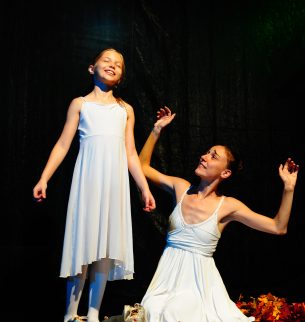
Die bunten Schuhe - Nur ein Traum?

A ballet set to the music of Anton Bruckner. The libretto, concept and choreography are all from Stoyanova Ivelin accompanied by Petra Slottova on the flute. The dancers are students of the MAESTRO Theatre Ballet School with the support of the ATEM Dance Company.
Stoyanova Ivelin | Choreography, libretto, concept and artistic direction
Petra Slottova | Flute
Pupils and Copagnie ATEM from theMAESTRO Schhol of Ballet| Dancers
Rossitza Ekova Stoyanova | Costumes
Iassen Stoyanov | Stage design
Bismarckstrasse 18 4020 Linz Details & Tickets
Sa. 05.10.24
19:30
Linz
Brucknerhaus Linz
Internationales Brucknerfest Linz 2024
Chorus Viennensis & Sonat Vox
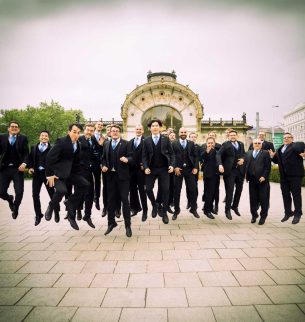
Chorus Viennensis & Sonat Vox

Anniversarium MMXXIV
Anton Bruckner felt a deep connection to the men's choral societies so characteristic of the 19th century from a young age. In the 1840s, he founded male quartets in both Kronstorf and St. Florian, in which he himself took part as second and first bass respectively, and joined the "Frohsinn" choral society in Linz in 1856, where he was subsequently elected choirmaster twice. From 1843 onwards, Bruckner wrote works for such choral societies for 50 years, i.e. his entire creative life, and was already described in Julius Schuberth's Musikalisches Conversations- Lexicon in 1877 as an "important composer of male choirs with and without orchestra" . His contemporaries Bedřich Smetana and Peter Cornelius, who together with Bruckner form the trio of 200-year-olds, followed in his footsteps and created a large number of patriotic, festive, nature, hunting, mourning and love songs for unaccompanied male choir.
In order to present the broadest possible cross-section of this charming but largely forgotten repertoire, the renowned Chorus Viennensis, consisting of former Vienna Boys' Choir, and the up-and-coming a cappella male ensemble Sonat Vox, whose members sang in the Windsbach Boys' Choir in their childhood, two top-class male choirs have joined forces to perform the music of the three jubilarians on German and Czech texts, sometimes alternately, sometimes together, thus presenting a program that is as unusual as it is unforgettable.
Anton Bruckner (1824-1896)
"An dem Feste" in D flat major for four-part male choir a cappella, WAB 59a (1843)
Bedřich Smetana (1824-1884)
Prayer (Modlitba) for male choir a cappella, JB 1:120 (1880)
Peter Cornelius (1824-1874)
Five funeral choruses for male voices, op. 9 (1869)
Bedřich Smetana
Píseň na moři(Song on the Sea) for male choir a cappella, JB 1:106 (1876-77)
Anton Bruckner
"Lebt wohl, ihr Sangesbrüder" A major for four-part male choir a cappella, WAB 83, No. 2 (1851)
Der Abendhimmel (I) in A flat major for male quartet a cappella, WAB 55 (1862)
Bedřich Smetana
Dedication (Věno) for male choir a cappella, JB 1:119 (1880)
- Intermission -
Peter Cornelius
Sunrise, No. 3 from: Three four-part male choirs, op. op. (1844)
Anton Bruckner
Träumen und Wachen in A flat major for tenor solo and four-part male choir a cappella, WAB 87 (1890)
Peter Cornelius
The Old Soldier, No. 1 from: Three male choirs, op. 12 (1873)
Bedřich Smetana
Festive choir (Slavnostní sbor) for male choir a cappella, JB 1:99 (1870)
Peter Cornelius
"Es war ein alter König", No. 2 from: Three four-part male choirs, op. op. (1844)
Anton Bruckner
Serenade in G major for male quartet a cappella, WAB 84, No. 2 (around 1846)
"Im Wort und Liede wahr und fei" in C major for four-part male choir a cappella, WAB 148, No. 1 (1869)
Shooting Stars in F major for four male voices a cappella, WAB 85 (c. 1848)
Am Grabe in F minor for four-part male choir a cappella, WAB 2 (1861)
Der Abendhimmel (II) in F major for four-part male choir a cappella, WAB 56 (1866)
Trösterin Musik in C minor for four-part male choir a cappella, WAB 81b (1877)
Chorus Viennensis
Sonat Vox
Michael Schneider,
Justus Merkel | Management
Sa. 05.10.24
19:30
Linz
StifterHaus
Norbert Trawöger - Bruckner! Journal einer Leidenschaft
Mittag mit Bruckner

Mittag mit Bruckner

With this year's lunch series "Lunch with Bruckner", the StifterHaus invites you to take a look at Anton Bruckner. The focus will be on the Bruckner Year and the events associated with this in general. Particular attention will also be paid to Anton Bruckner in literature.
Norbert Trawöger - Bruckner! Journal of a passion
A passionate approach to the music of Anton Bruckner by the well-known musician, Norbert Trawöger. Norbert Trawöger developed a passion for Anton Bruckner at the tender age of eight and it continues to this day. In his journal, he talks with relish about his experience with Bruckner and his music and warns us not to confuse the creator and his work.
StifterHaus
Adalbert-Stifter-Platz 1 4020 Linz
Sa. 05.10.24
20:00
Linz
Posthof
Next Bruckner - Die Konzertreihe kuratiert von Ina Regen
Oska

Oska

The songs of the young Waldviertel native living in Vienna are slightly darkened, but never completely sinister. Even at a discreet room volume, her sensitive singer-songwriter pop completely captivates you. The intimate sound conveys a melancholy that always resonates in her tracks. Difficult moments are the best source of inspiration for Oska.
She hit the big time in mid-2020. The singer/songwriter signed her first record deal with the Canadian label Nettwerk, won the XA Music Export Award at the Waves Vienna Festival 2020 shortly afterwards, released her debut EP "Honeymoon Phase", landed many of her songs in the Austrian airplay charts and won her first Amadeus Austrian Music Award in the "Best Sound" category in 2022. With plays on the cultural radio station Ö1, the mainstream radio Ö3 and the alternative music radio FM4, she managed a balancing act in her home country that only very few artists are rewarded with in Austria. In addition to all the major publications in her home country, Oska has also won over the press in Germany, Holland, France, Italy and even the USA.
Maria is currently living out her rich musical heritage in Vienna, where she has completed her album "My world, My love, Paris". As Oska, she creates a tantalizing world of radiant melodies, groovy rhythms and poetic lyrics that tell stories. Ultimately, despite its disparate themes of love, grief, climate change and family, "My world, My love, Paris" is a snapshot of a young woman trying to make sense of growing older in an increasingly uncertain time.
Next Bruckner - The concert series curated by Ina Regen
11 concert evenings from January to November 2024 at Posthof Linz
Co-production: Posthof - Zeitkultur am Hafen
Ina Regen | Curation
Posthof - Zeitkultur am Hafen, Ina Regen | Co-production
Posthofstrasse 43 4020 Linz Details & Tickets
So. 06.10.24
17:00
Linz
Francisco Carolinum
Ballot Quintett
Landeskonzerte - Sonntagsmusik im Salon
Landeskonzerte - Sonntagsmusik im Salon
In addition to a string quintet by Michael Haydn, the Ballot Quintet will play Anton Bruckner's String Quintet and the Intermezzo for String Quintet originally conceived for this work, which offers a special insight into the history of the string quintet.
Office of the Provincial Government of Upper Austria; Department of Culture
Museumstrasse 14 4010 Linz
So. 06.10.24
18:00
Linz
Brucknerhaus Linz
Befreien – Bruckners 7. Sinfonie im Originalklang
Jérémie Rhorer & Le Cercle de l’Harmonie
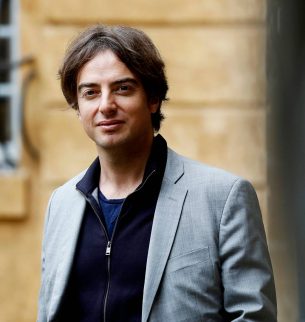
Jérémie Rhorer & Le Cercle de l’Harmonie

Bruckner's symphonies in their original sound
Liberate
Just three weeks after completing his 'Sixth Symphony', Anton Bruckner began composing No. 7 in E major on 23 September 1881 going on to complete it in St. Florian on 5 September 1883, just like his first work. Although the influential critic ,Eduard Hanslick, later desribed it disparagingly as a"giant symphonic snake", the work soon began its triumphal march. It earned the 60-year-old the recognition he had long coveted as a symphonic composer. He described his most famous movement, the Adagio, in which Bruckner uses so-called Wagner tubas for the first time and which has audible references to "Siegfried's Funeral March" from Götterdämmerung - Bruckner had become acquainted with the entire Ring of the Nibelung during his visit to the Bayreuth Festival in 1876 - as "funeral music (in memory of the master's passing)"as a result of the impression Richard Wagner's death on 13 February 1883 had on him.
In many respects, Ernest Chausson's three-movement Symphony (No. 1) in B flat major, composed in 1889 and 1890, is a comparable document of the composer's self-emancipation and ultimate detachment from his previously overpowering role model, Wagner. The slow middle movement has the character of a confessional lament, while the finale echoes the music of Parsifal which was intended for Klingsor.
In this concert, the outstanding original sound orchestra "Le Cercle de l'Harmonie", directed expertly and in an electrifying manner by its founder, Jérémie Rhorer, continues its now internationally acclaimed exploration of Bruckner's work which began at the International Brucknerfest Linz in 2020. It also draws attention to this milestone in the history of French symphonic music since it is being performed at the Brucknerhaus Linz for the first time.
.
Ernest Chausson (1855-1899)
Symphony (No. 1) in B flat major, op. 20 (1889-90)
- Intermission -
Anton Bruckner (1824-1896)
Symphony No. 7 in E major, WAB 107 (1881-83)
Le Cercle de l'Harmonie
Jérémie Rhorer | Conductor
Di. 08.10.24
12:30-13:00
Linz
StifterHaus
Mittag mit Bruckner

Mittag mit Bruckner

With this year's lunch series "Lunch with Bruckner", the StifterHaus invites you to take a look at Anton Bruckner. The focus will be on the Bruckner Year and the events associated with this in general. Particular attention will also be paid to Anton Bruckner in literature.
StifterHaus
Adalbert-Stifter-Platz 1 4020 Linz
Di. 08.10.24
19:30
Linz
Brucknerhaus Linz
Anbeten - Bruckners 5. Sinfonie im Originalklang
Ádám Fischer & The Orchestra Of The Age Of Enlightenment
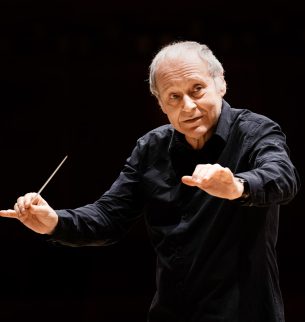
Ádám Fischer & The Orchestra Of The Age Of Enlightenment

Bruckner's symphonies in their original sound
Adoration
Anton Bruckner's Symphony No. 5 in B flat major, which he composed between February 1875 and May 1876 and called his "contrapuntal masterpiece" , is a truly powerful work. It is permeated by a dense network of motivic relationships. The final movement was considered to be the "most monumental finale in the entire musical literature of the world" by the conductor, Wilhelm Furtwängler.
The composer never heard his work in its original form, which was not premiered until 1935, and only added a bass tuba to the orchestra and changed a few minor details in the course of a revision between May 1877 and January 1878. There is therefore only one single version of this symphony.
Throughout his life Bruckner considered Wolfgang Amadé Mozart's Requiem in D minor to be a central work and it proved to be an important point of reference for his own church music. He also repeatedly analysed its score in great detail as is evidenced by voice leading studies, the results of which he entered in his Krakow writing diary in 1877. What is less well known, however, is that it served to a certain extent as a blueprint and 'motif source' for his 'Fifth'. In addition to a literal quotation of the phrase„Qua resurget ex favilla / Iudicandus homo reus“from the „Lacrymosa“in the second movement of the symphony, almost all of the themes of all four movements of the work refer to the Requiem.
Presumably for the first time ever, the world-famous Orchestra of the Age of Enlightenment and Ádám Fischer, one of the most important conductors of our times, supported in the Mozart Requiem by an excellent quartet of soloists and the outstanding Ad Libitum Choir, will allow listeners to experience this exciting connection by juxtaposing the two works in one concert.
Wolfgang Amadé Mozart (1756-1791)
Requiem in D minor, KV 626 (1791) [after the edition of the completion by Franz Xaver Süßmayr (1766-1803) published in 1877 and edited by Johannes Brahms (1833-1897)]
- Intermission -
Anton Bruckner (1824-1896)
Symphony No. 5 in B flat major, WAB 105 (1875-76, rev. 1877-78)
Fenja Lukas | Soprano
Michaela Selinger | mezzo-soprano
João Terleira | Tenor
Alexandre Baldo | Bass
Choir Ad Libitum
The Orchestra of the Age of Enlightenment
Ádám Fischer | Conductor
Mi. 09.10.24
20:00
Linz
Mariendom
Internationales Brucknerfest Linz 2024
Markus Poschner & Oberösterreichisches Jugendsinfonieorchester
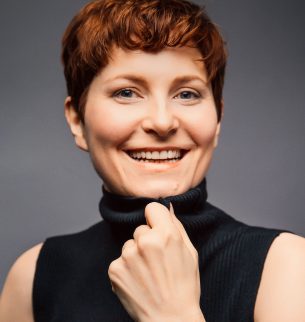
Markus Poschner & Oberösterreichisches Jugendsinfonieorchester

Bruckner in St. Mary's Cathedral
Anton Bruckner's Missa solemnis in B flat minor, composed in 1854, represents the sum of his engagement with tradition at the time and reveals influences from Johann Sebastian Bach, the Viennese classics and Franz Schubert, but also shows the considerable compositional skill he had acquired in the meantime, for example in the fugue work. The mass surprises with its unusual opening key of B flat minor, which brightens to B flat major as it progresses. In contrast, the famous Te Deum, which Bruckner completed 30 years later without a corresponding commission or the concrete prospect of a performance opportunity, begins in glistening C major. The outstanding importance that this hymn had for its creator is expressed not least in the fact that he described it as the "pride of his life" and "his best work" .
The orchestral work Elysium by the then 40-year-old Canadian composer and conductor Samy Moussa, which refers to Bruckner's Symphony No. 4(Romantic) in E flat major and was premiered by the Vienna Philharmonic under the direction of Christian Thielemann in Barcelona's Sagrada Família in 2021, acts as a 'sound bridge' between the ambitious mass composition by the almost 30-year-old and the masterful hymn to God, which he completed at the age of almost 60.
At this church concert, the voices of four excellent soloists and a large number of talented young choir singers from all over Upper Austria are entrusted with the service and prize of sound. The Upper Austrian Youth Symphony Orchestra, which accompanies them and is made up of the best young musicians in the state, is conducted by its patron Markus Poschner.
Anton Bruckner (1824-1896)
Missa solemnis in B flat minor for soloists, four-part mixed choir, orchestra and organ, WAB 29 (1854)
Samy Moussa (* 1984)
Elysium for orchestra (2021)
Anton Bruckner
Te Deum in C major for soloists, four-part mixed choir, orchestra and organ, WAB 45 (1881, 1883-84)
Fenja Lukas | Soprano
Michaela Selinger | mezzo-soprano
João Terleira | Tenor
Alexandre Baldo | bass-baritone
Mozart Choir of the Musikgymnasium Linz
Upper Austrian State Youth Choir
Upper Austrian
Youth Symphony Orchestra
Markus Poschner | Conductor
Mi. 09.10.24
bis Fr. 11.10.24
20:00
Linz
Posthof
von Paulus Hochgatterer
Manuela Linshalm spielt "Der schlafende Wal"

Manuela Linshalm spielt "Der schlafende Wal"

A "something", an "in-between", a young punk is obliged to perform one hundred hours of community service for various offenses with an elderly lady who is unable to leave her room due to her mobility restrictions. The woman reads books that don't interest the girl and listens to music that always sounds the same to her. It turns out that due to her absent husband, the elderly lady has spent her whole life listening to Anton Bruckner and his symphonies, especially his Seventh. The lessons that can be drawn from Bruckner's work for a correct life seem never-ending. And how easily one is inclined to find something ridiculous because one does not recognize complexity, humility and sublimity. But the audience soon notices a horror that lies beneath the glorification, a limiting of the horizon in the explanation of the world, a defense of an unspoken accusation. Although the young woman defends herself to the best of her ability, a relationship develops with the old woman. Two women in different phases of life and with contrasting pasts find a new beginning through each other.
Manuela Linshalm is a freelance actress, puppeteer and lecturer at the Filmacademy Vienna. After training at the Franz Schubert Conservatory and apprenticeships with Nikolaus Habjan and Neville Tranter, she has been performing continuously at the Schubert Theater Vienna since 2009, where three solo puppet theater pieces have appeared to date (most recently "Die Welt ist ein Würstelstand"). Other engagements include the Akademietheater Wien, Theater an der Wien, Residenztheater München, Landestheater NÖ, Vereinigte Bühnen Bozen, Bayerische Staatsoper, Volkstheater Wien, Rabenhof Theater, Next Liberty Graz, Theater in der Josefstadt, Theater Dortmund and many more.
Paulus Hochgatterer lives as a storyteller, playwright and child and adolescent psychiatrist in Vienna and in the Waldviertel. His narrative work has been translated into more than 15 languages and has won numerous awards. In recent years, his plays have been performed at various theaters in the German-speaking world, including the Schauspielhaus Graz, the Residenztheater Munich, the Schauspielhaus Stuttgart, the Burgtheater Vienna and the Opera Festival in Bayreuth. Most of his stage works were created for the Austrian director and puppeteer Nikolaus Habjan.
The sleeping whale
Play by Paulus Hochgatterer
Play: Manuela Linshalm
Director, set: Simon Meusburger
Puppets: Soffi Povo
Co-production: Posthof - Zeitkultur am Hafen, Schubert Theater Vienna
World premiere: 9.10.2024 Posthof, Linz
Posthofstrasse 43 4020 Linz Details & Tickets
Do. 10.10.24
19:30
Linz
Brucknerhaus Linz
Vergöttern – Bruckners 9. Sinfonie im Originalklang
Jakob Lehmann & Les Siècles

Jakob Lehmann & Les Siècles

Bruckner's symphonies in their original sound
Deifiance
Anton Bruckner began composing his Symphony No. 9 in D minor on 12 August 1887, just two days after he had (initially) completed the 'Eighth'. The fact that he was unable to complete it before his death on 11 October 1896 had less to do with his age or a decline in his creative powers and more to do with a three-year interruption in his work on the new material. During this period, he fundamentally revised four of his symphonies. Bruckner is said to have confided to his doctor shortly before his death that he wanted to dedicate the 'Ninth ' "to the good Lord" in the hope "that he will give me enough time" to"complete it". The three-movement torso, which is where he left the symphony at the end, pushes forward to the limits of tonality through the "unqualified unleashing of the harmonic centrifugal forces" thus leaving the door to the music of the 20th century wide open.
The monumental fragment is combined with Wolfgang Amadé Mozart's Symphony No. 41 in C major, which the concert organizer Johann Peter Salomon, probably at the beginning of the 19th century, gave the nickname "Jupiter" to express the almost divine perfection of this symphonic masterpiece, which has never been surpassed.
Wolfgang Amadé Mozart (1756-1791)
Symphony No. 41 ("Jupiter") in C major, KV 551 (1788)
- Intermission -
Anton Bruckner (1824-1896)
Symphony No. 9 in D minor, WAB 109 (1887-94)
Les Siècles
Jakob Lehmann | Conductor
Fr. 11.10.24
11:00
Linz
Brucknerhaus Linz
Internationales Brucknerfest Linz 2024
Schubert & Bruckner Unfinished 14+
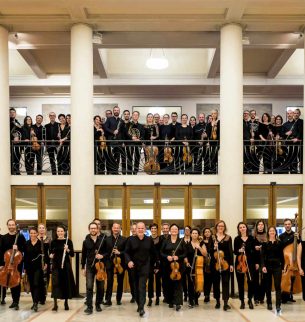
Schubert & Bruckner Unfinished 14+

Two unfinished symphonies
Under the direction of its chief conductor François-Xavier Roth, the celebrated original sound orchestra Les Siècles will present two symphonies that remained unfinished at this An.Ton.Hören school concert for the 14+ age group.
Firstly, Anton Bruckner's 'Ninth', which he initially did not really want to begin composing, as he confessed to his pupil Josef Gruber: "'I' mag dö Neunte gar nöt anfangen, i' trau mi' nöt, denn', he said solemnly continuing in written German, 'auch Beethoven machte mit der Neunten den Abschluss seines Lebens'." Bruckner left his work as a three-movement fragment, although there were nine years between the start of work on it and his death, during which he was partly occupied with revising his other symphonies. On the other hand, Franz Schubert's Symphony No. 7 in B minor can be heard, of which he only completed the first two movements. He abandoned work on the third movement after just a few bars for unknown reasons. Ludwig van Beethoven was also Schubert's great role model. It is therefore quite possible that he did not complete his symphony, which became famous as the "Unfinished" , because he feared that it would not meet his own expectations and would not stand up to comparison with the works of his idol.
Excerpts from:
Franz Schubert (1797-1828)
Symphony No. 7 ("Unfinished") in B minor, D 759 (1822)
Anton Bruckner (1824-1896)
Symphony No. 9 in D minor, WAB 109 (1887-94)
Les Siècles
François-Xavier Roth | Conductor
Do. 17.10.24
20:00
Linz
Mariendom
Uraufführung mit Cantando Admont
Komponieren in HIMMLISCHER HÖHE. Eine Kompositionswerkstatt
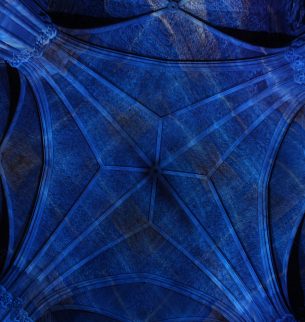
Komponieren in HIMMLISCHER HÖHE. Eine Kompositionswerkstatt

The Composition Workshop: Composing in HIMMLISCHER HÖHE aims to be a place that offers young composers space for exciting sound experiments in and with Austria's largest church. On the occasion of the anniversaries "100 years of the Mariendom Linz" and "200 years of Anton Bruckner", it offers the extraordinary opportunity for an intensive exchange between young composers (born in 1998 and later) and professional musicians as well as an exciting experience for the (sound) artistic career.
The vocal compositions, which were created following a workshop in the footsteps of Anton Bruckner and St. Mary's Cathedral as well as a composition residency in the Türmerstube at a height of 68 meters above Linz, will be premiered at the presentation concert by the renowned Ensemble Cantando Admont under the direction of Cordula Bürgi in the presence of the young sound creators.
Accessibility:
St. Mary's Cathedral
Phone number
e-mail
A project of the Upper Austrian KulturEXPO Anton Bruckner 2024
Ensemble Cantando Admont Vocal Ensemble | Vocal Ensemble
Cordula Bürgi | Management
Cathedral Square 1 4020 Linz Details & Tickets
Fr. 18.10.24
15:00-18:00
Linz
Direktion Kultur und Gesellschaft, Festsaal
Crash-Kurs

Crash-Kurs

Are you curious about Bruckner? Would you like to dive deeper into the world of the composer and the man himself? Would you like to pass on your own enthusiasm and knowledge?
Take advantage of this entertaining course offering all the music and information from and about Bruckner that it will take to expand your Bruckner horizons.
Number of participants:
The crash course will take place with a minimum of 5 participants and is restricted to 25 participants.
Promenade 37 4020 Linz Details & Tickets
Fr. 18.10.24
19:00
Linz
Mariendom
Anton Bruckner Motetten Crash

Anton Bruckner Motetten Crash

All the great Bruckner motets are interpreted in one place by different choirs and given an innnovative twist propelling them into the 21st century.
The choirs are spread out in different places in the New Cathedral in Linz. Each choir takes its turn singing its chosen motet.
At the end of the event, all the motets will sound simultaneously, culminating in a joint "Locus iste".
Admission: voluntary donations!
Choir Association Upper Austria
Member choirs of the Choir Association of Upper-Austria
Cathedral Square 1 4020 Linz Details & TicketsFurther dates in the series
@ Sonnenstein Loft (Linz)
@ Holy Hydra Linz (Linz)
@ Holy Hydra Gmunden (Gmunden)
Sa. 19.10.24
19:30
Linz
Sonnenstein Loft
Further dates
Elektronisches Orgelkonzert, Bruckner‘s Sound Remixes & Sound Installation & Performance
Bruckner’s Beats
@ Sonnenstein Loft

Bruckner’s Beats
@ Sonnenstein Loft

Bruckner as part of the club scene? In April, the STREAM CLUB and students from the state music school studying digital music production proved that this is possible. And the beat goes on: "This all began with the idea to generate new approaches to Anton Bruckner's classical music," Ilona Roth from Transitheart Productions explains. The latter is a label for artistic productions in the field of contemporary dance and theatre with interfaces to performance art, film and video. Together with the Linz-based collective Holy Hydra, she devised Bruckner's Beats and presents pieces by Bruckner featuring electronic remixes and new arrangements in a club atmosphere. Sound installations, performances, art happenings and interventions - thus Anton Bruckner becomes danceable and tangible.
In three rooms, you can listen to interpretations of Bruckner's symphonies by DJs and musicians, immerse yourself in parallel worlds of sound, accompanied by live interaction from dancers, via a headphone audio system on three channels. Along the way, you can talk about Bruckner, toast him and philosophize about him. Supported by club sounds - loud and quiet at the same time - thoughtful but also danceable, ambivalent like Bruckner himself.
Admission fee:
Full payer: € 15,-
Reduced: € 10,-
Free: Kulturpass Hunger for Art & Culture & people with disabilities
Tickets are available via the button below or by calling +43 (0) 732 7720-15665.
Tickets are also available at the box office on the day of the event, cash only.
A project of the Upper Austrian KulturEXPO Anton Bruckner 2024
Transitheart Productions coop Holy Hydra
Clemens Riedl | Organ; E:K:V
Stefan Weissenberger | trumpet & electronics; E:K:V
Björn Büchner | Electronics; E:K:V
Audiomojo | Sound Remixes
LynnMayya | Sound Remixes
Reinhard Reisenzahn | Sound Remixes
Lilli Jungin Lee | Lee Jung In Creation - dance performance
Seo Jin Moon | Lee Jung In Creation - dance performance
Yeram Kand | Lee Jung In Creation - dance performance
Seung Ju Lee | Lee Jung In Creation - dance performance
Sonnensteinstrasse 11-13 4040 Linz



Do. 24.10.24
20:00
Linz
Stadtpfarrkirche Urfahr / Grüner Anker
Künstlerische Arbeit zu Anton Bruckners Phantasmagorie
Halluzination. Anton Bruckners Phantasmagorie
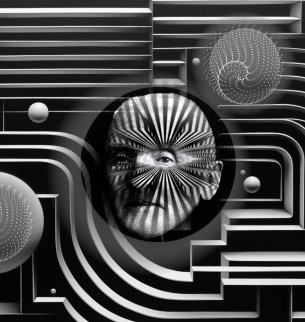
Halluzination. Anton Bruckners Phantasmagorie

Hallucination. Anton Bruckner's Phantasmagoria is a new staging of his 1868 work "Remembrance" that combines AI, live music, performance, visualization and light. The multimedia artist CRYSTN HUNT AKRON and her partners, Chris Noelle and Ali Nikrang, breathe new life into this work.
Art makes use of artificial intelligence: it generates a piece that represents a kind of memory of "memory" and is rearranged and remixed.
In this project, the entire space of the church is visually and acoustically incorporated and auratically transformed. The result is a musical-visual journey from classical to avant-garde to experimental.
CRYSTN HUNT AKRON | Artistic direction & idea
Patrik Huber | Performance
Stefan Mittlböck-J.-F. | Accordion Noise
Kefermark alphorn players
Dance students of the ABPU | Directed by Iris Heitzinger
Chris Noelle | Visualization
Gerald van der Kolk | Visualization
Ali Nikrang (Ars Electroncia Futurelab) | AI Music
CRYSTN HUNT AKRON | voice, organ, synthesizer, composition
more artists from Upper Austria
Cornelia Lehner | Project Management
Full payer:in: € 15,-
Reduced: € 10,-
Senior citizens, persons on military and civilian service, apprentices and students up to the age of 27, LPA card, family card, Linz Kulturcard 365, Linz Card
Proof of the discount must be presented at the start of the event.
Free
Culture pass Hunger for art & culture
People with disabilities
Tickets available online here or by phone: +43 (0) 732 7720-15665
Accessibility:
Klemens Hager
+43 (0) 676 8776-5656
klemens.hager@dioezese-linz.at
A project of OÖ KulturEXPO Anton Bruckner in cooperation with AEC, St. Josef Parish Church and Anton Bruckner Private University with the kind support of the Federal Ministry of Arts, Culture, Civil Service and Sport.
Schulstrasse 4
4040




Sa. 26.10.24
10:30
Linz
Brucknerhaus Linz
Puppentheater für Families & Kids
Kasperl und die Orgelpfeifen
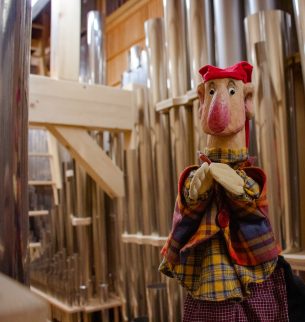
Kasperl und die Orgelpfeifen

Punch and the organ pipes.
A puppet show about the Brucknerhaus organ for everyone aged 4 and over
The imposing organ, which sits enthroned at the back of the stage, is without a doubt the centrepiece of the Great Hall in the Brucknerhaus Linz. This is also the place where a very special Punch and Judy show is performed for families and children aged 4 and over. Both the stage and the organ become the venue. The protagonists, Punch and Judy, will embark on an exciting adventure. They have to find three organ pipes that have escaped. The three pipes have decided that they no longer want to stay in the dark organ case and have set off to seek their fortune in the big, wide world. But Anton Bruckner's ghost still wants to play his organ at night and needs all the organ pipes to do so. Punch has to help him! Working with members of the audience sitting on the stage, will he succeed in bringing the three runaways back?
Caroline Atschreiter | Organ
Gerti Tröbinger, Maximilian Tröbinger | Story, puppetry & production
Gerti Tröbinger | Equipment & puppet production
A cooperation project between the Kuddelmuddel Children's Cultural Centre and the Brucknerhaus Linz
Mo. 28.10.24
bis So. 11.02.24
Uhrzeit folgt!
Linz
WEBLAB
Toni On Tour
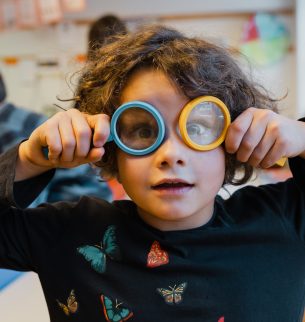
Toni On Tour

TONI ON TOUR, a summer tour of the Upper Austrian Children's University with Anton Bruckner. Children can spend a day delving into the fascinating life of Toni at all of the locations in Upper Austria and experience a creative combination of science and music. A music which features old and new, classical and contemporary worlds of music. TONI, our little explorer, loves to collect musical treasures in Upper Austria. At the graduation ceremony in Stey in August, he will present a concert full of variety.
Registration: Monday, 16.10.2024 from 18:00
A project of the Upper Austrian KulturEXPO Anton Bruckner 2024 in cooperation with the KinderUni
KinderUni Upper Austria (supporting organization: Institute for Applied Environmental Education)
Details & Tickets
Mo. 28.10.24
19:30
Linz
Brucknerhaus Linz
Sinfoniekonzert

Sinfoniekonzert

UAS-UpperAustrianSinfonietta
Conductor: Peter Aigner
Soloist: Eleonor Sophie Plöchl, marimba
Johannes Brahms: (1833- 1897)
Selection from the Hungarian Dances WoO 1 (1869, 1880)
Hungarian Dance No. 13 in D major
Hungarian Dance No. 11 in D minor
Hungarian Dance No. 20 in E minor
Tina Geroldinger (* 2000)
Expedition North Pole - Anton Bruckner's dream journey
Tristan Schulze (*1964)
Concerto for marimba and orchestra, op. 95
Anton Bruckner: (1824 - 1896)
Symphony in F minor, WAB 99 "Study Symphony"
LIVA and Upper Austrian Music School Association
UAS-Upper Austrian Sinfonietta | Orchestra
Peter Aigner | Conductor
Eleonor Sophie Plöchl | Soloist
Lower Donaulände 7 4020 Linz Details & Tickets
Do. 31.10.24
20:24-21:00
Linz
Ölbergkapelle
Dead Man Walk

Dead Man Walk

We think so much of Anton Bruckner that he is alive again. On Halloween, October 31, 2024 at 8:24 pm, Peter Androsch will walk around the parish church with everyone who wants to be there, dressed in his Bruckner death masks, led by wind players layering the famous opening motif from Bruckner's Fourth. The cardboard death masks are available from Peter Androsch and/or at remember-bruckner.com.
Peter Androsch
Peter Androsch and many others.
Pfarrplatz 20 4020 Linz
Di. 12.11.24
19:30
Linz
Volkshaus Kleinmünchen
Vortrag von Rektor Martin Rummel
David Popper (1843-1913) - Cello-Superstar des 19. Jahrhunderts

David Popper (1843-1913) - Cello-Superstar des 19. Jahrhunderts

Wagner, Bruckner, Brahms, Grieg or Tchaikovsky: he knew them all and they held him in great value. David Popper was one of the few cellists who achieved international fame as a soloist in the 19th century even becoming a darling of the tabloid press. Nevertheless, he is far less well known today than, for example, Franz Liszt, who called him to his newly founded academy in Budapest. Martin Rummel investigates why this is the case.
Free admission!
Accessible for those with impaired mobility!
Richard Wagner Association Linz
Dauphinestrasse 19 4020 Linz
Mi. 13.11.24
17:00-20:00
Linz
Direktion Kultur und Gesellschaft, Festsaal
Crash-Kurs

Crash-Kurs

Are you curious about Bruckner? Would you like to dive deeper into the world of the composer and the man himself? Would you like to pass on your own enthusiasm and knowledge?
Take advantage of this entertaining course offering all the music and information from and about Bruckner that it will take to expand your Bruckner horizons.
Number of participants:
The crash course will take place with a minimum of 5 participants and is restricted to 25 participants.
Promenade 37 4020 Linz Details & Tickets
Di. 19.11.24
12:30-13:00
Linz
StifterHaus
Mittag mit Bruckner

Mittag mit Bruckner

With this year's lunch series "Lunch with Bruckner", the StifterHaus invites you to take a look at Anton Bruckner. The focus will be on the Bruckner Year and the events associated with this in general. Particular attention will also be paid to Anton Bruckner in literature.
StifterHaus
Adalbert-Stifter-Platz 1 4020 Linz
Fr. 22.11.24
20:00
Linz
Posthof
Next Bruckner - Die Konzertreihe kuratiert von Ina Regen
Ina Regen & Friends
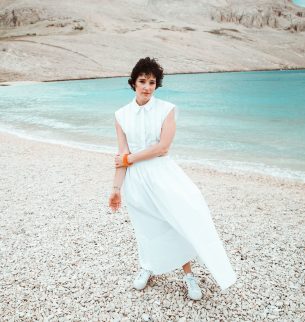
Ina Regen & Friends

The new Ina Regen is colourful and light but as poetic and true to life as usual. Almost two years to the day have passed since the #1 album "røt". Two years of excitement but first and foremost intense and turbulent. Years that have affected and impacted the world as a whole. Times that have naturally not left a sensitive artist like Ina Regen unscathed. This served as sufficient impetus to initiate a number of changes and give expression to her own experiences in this time in her music, to make them audible.
The music that the Vienna-based singer-songwriter presents to her fans this time is almost as colourful as the album cover itself. It can be interpreted as the consistent further development of a charismatic, energetic and eloquent artist or as an expression of the new-found self-confidence of a woman whose voice has become an indispensable companion for large sections of the public. Above all it expresses the joy of breaking through the boundaries she once imposed on herself and reinventing herself. It is sometimes surprising and yet she remains true to herself. "If I had to give this creative period a title, it would be 'Emancipation'," Ina Regen says.
Ina Regen has also emancipated herself on a professional level. "Fast wie Radlfahrn" (almost like riding a bike) is the first album on her own label ,Nannerl. For the Amadeus Award winner, this step towards independence was a logical step in her career. "Over the last few years, I have increasingly understood that my creativity is nourished by a playful impulsiveness and an unwavering gut feeling. The greatest possible self-determination is the only way to happiness for me personally to ensure that my profession continues to bring me this joy and that my music can also be part of my honest attitude towards life in the long term. "
Next Bruckner - The concert series curated by Ina Regen
11 concert evenings from January to November 2024 at Posthof Linz
Co-production: Posthof - Zeitkultur am Hafen
Ina Regen | Curation
Posthof - Zeitkultur am Hafen, Ina Regen | Co-production
Posthofstrasse 43 4020 Linz Details & Tickets
So. 01.12.24
16:00
Linz
Mariendom
Symphonieorchester der ABPU Solist:innen, Chor und Kinderchor
WEIHNACHTSKONZERT

WEIHNACHTSKONZERT

Programme:
Anton Bruckner (1824-1896), Adagio from the String Quintet in the version designed for string orchestras.
Anton Bruckner Private University
Guido Mancusi | Conductor
4020 Linz
Do. 05.12.24
19:00
Linz
Anton Bruckner Privatuniversität
Anton Bruckner - „Coming of Age“

Anton Bruckner - „Coming of Age“

In Bruckner's sketches, which were written during his time as a teacher and later as a monastery organist in St. Florian, numerous copies of works by other composers can be found. The composer was particularly interested in the art of writing fugues and church music. He developed his own technique by copying mostly contrapuntal works by J.G. Albrechtsberger, M. Haydn, A. Caldara, J.S. Bach, W.A. Mozart and other musicians. The sketches also include a copy of an Ave Maria by Franz Joseph Aumann, the Floriani choirmaster.
Under the direction of Elisabeth Wiesbauer, the Euridice Baroque Orchestra will perform symphonies by J.G. Albrechtsberger and M. Haydn on period instruments alongside Aumann's Ave maria.
Anton Bruckner Private University
Elisabeth Wiesbauer | Coordination
Students Institute ALT
Alice-Harnoncourt-Platz 1 4040 Linz Details & Tickets
So. 08.12.24
16:00
Linz
Mariendom
BRUCKNER - TE DEUM
Festakt zum Abschluss des Jubiläumsjahres "100 Jahre Mariendom"

Festakt zum Abschluss des Jubiläumsjahres "100 Jahre Mariendom"

Bruckner's Te Deum will be performed in the Cathedral of Linz at the ceremony to mark the end of the anniversary "100 years of St. Mary's Cathedral".
Cathedral music & Pro Mariendom
Josef Habringer | Director
Cathedral organist Wolfgang Kreuzhuber | Organ
Linz Cathedral Choir (conducted by Andreas Peterl)
Collegium Vocale Linz
Orchestra and soloists of the Dommusik Linz
Cathedral Square 1 4020 Linz Details & Tickets
Mo. 09.12.24
17:00-20:00
Linz
Direktion Kultur und Gesellschaft, Festsaal
Crash-Kurs

Crash-Kurs

Are you curious about Bruckner? Would you like to dive deeper into the world of the composer and the man himself? Would you like to pass on your own enthusiasm and knowledge?
Take advantage of this entertaining course offering all the music and information from and about Bruckner that it will take to expand your Bruckner horizons.
Number of participants:
The crash course will take place with a minimum of 5 participants and is restricted to 25 participants.
Promenade 37 4020 Linz Details & Tickets
Fr. 13.12.24
bis Sa. 14.12.24
15:00
Linz
Sonnenstein Loft
ANTON: THE ESCAPE ROOM

ANTON: THE ESCAPE ROOM

ANTON is an innovative multimedia performance that combines music theatre and interactive elements, focusing on Anton Bruckner as its central figure.
The escape room can be played by a group of 2 to 5 people, aged between 12 and 100 and it takes around 40-60 minutes. Players will have to find their way out of the room by solving a series of puzzles in which they will interact with musical instruments, projections, electronics and vintage music recording media.
Tickets will be available online.
CLAMMY STUDIO
Óscar Escudero | composer
Belenish Moreno-Gil | stage designer
Andrés Ciprés | bassoonist
Sonnensteinstrasse 11-13 4040 Linz

